Nebraska is home to a wide variety of birds that are both native to the region and migratory. From hawks and falcons to songbirds and hummingbirds, Nebraska is an important stopover location for birds during their annual migration.
With an abundance of wetlands, rivers, and grasslands, Nebraska is the perfect place for birds to rest and refuel on their journey. With over 300 species of birds, Nebraska is an ornithologist’s paradise.
1. American Goldfinch
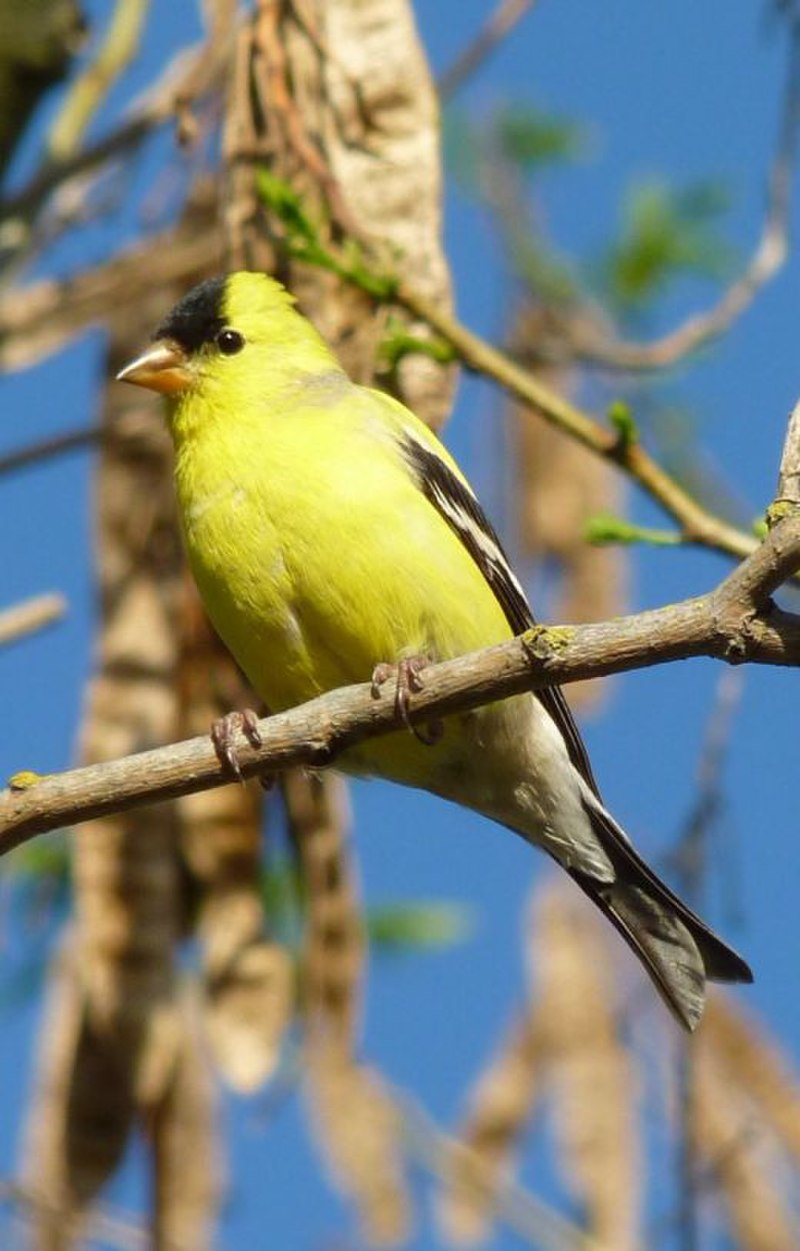
The American goldfinch is a small North American bird in the finch family. Males are vibrant yellow with black wings and tail, while females are duller in colouration.
It migrates from mid-Alberta to North Carolina during breeding season, south of Canada–United States border to Mexico for its wintering grounds.
The only finch which undergoes complete molt every year, it displays sexual dichromatism where males have brighter colours than their female counterparts.
They feed mainly on seeds but also eat insects such as aphids and caterpillars when raising youngs; they often occur near thistles or other plants that produce viable seed heads.
Their call consists of an array of chirps and trills making them quite conspicuous.Scientific classification:
| Kingdom | Animalia |
| Phylum | Chordata |
| Class | Aves |
| Order | Passeriformes |
| Family | Fringillidae |
| Subfamily | Carduelinae |
| Genus | Spinus |
| Species | S. tristis |
2. Northern Cardinal
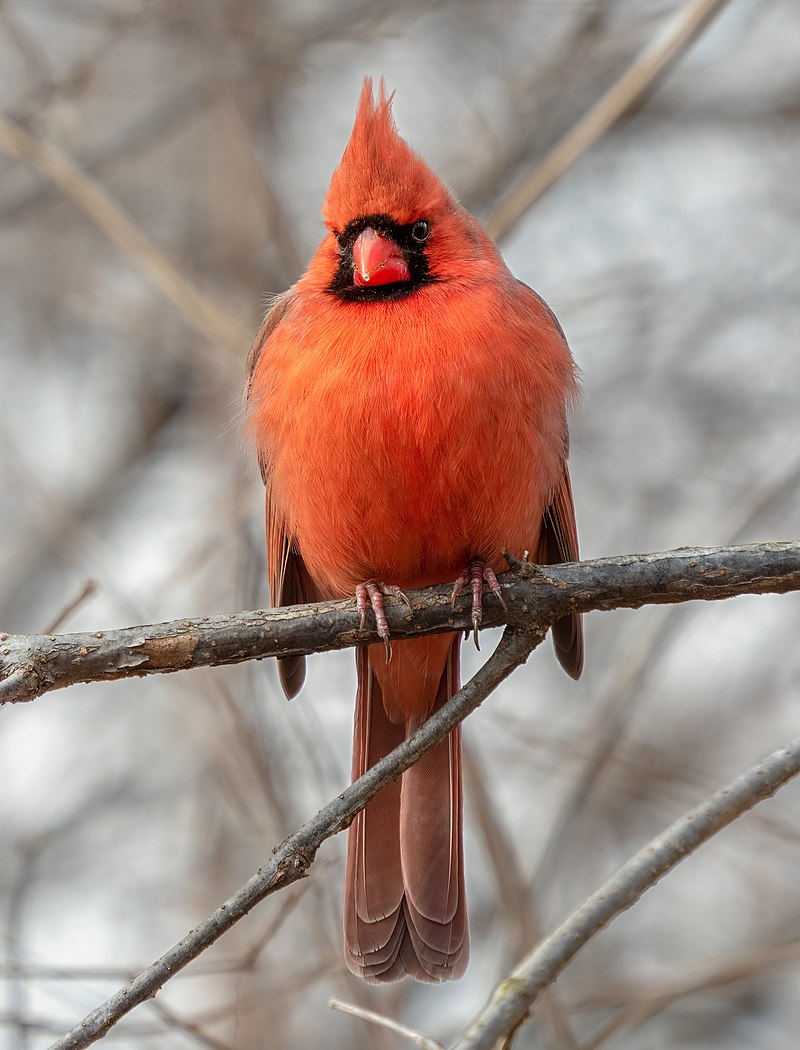
The Northern Cardinal is a beautiful bird, easily identified by its bright red plumage. It can be found in the eastern United States from Maine to Minnesota and south through Mexico and Belize.
Along with its striking colouration, it has a distinctive crest on its head and sharp black facial markings around the eyes.
Despite their small size (measuring 7-9 inches) they are very vocal birds – males sing persistently throughout springtime to attract mates or proclaim their territory.
They typically feed on insects, seeds and fruits but also enjoy suet at backyard bird feeders.
The female is less brightly coloured than her mate but still stands out among other songbirds due to her warm brownish-red feathers.
Cardinals pair for life so you may often see them together in your garden or neighbourhood park.Scientific classification:
| Kingdom | Animalia |
| Phylum | Chordata |
| Class | Aves |
| Order | Passeriformes |
| Family | Cardinalidae |
| Genus | Cardinalis |
| Species | C. cardinalis |
3. American Robin

The American robin is a migratory bird, belonging to the true thrush genus and Turdidae family.
It was named after its European counterpart due to the similar reddish-orange breast they both possess; however, they are not related closely.
This species can be seen through most of North America during winter months, as well as in parts of Mexico and Central America where it also breeds.
They have plump bodies with gray upperparts and white underparts that vary from yellow on their throats down to orange toward their bellies.
Robins feed on fruits such as berries or insects like worms which makes them an important part of ecosystems by helping disperse seeds naturally throughout these areas.Scientific classification:
| Kingdom | Animalia |
| Phylum | Chordata |
| Class | Aves |
| Order | Passeriformes |
| Family | Turdidae |
| Genus | Turdus |
| Species | T. migratorius |
4. Western Meadowlark
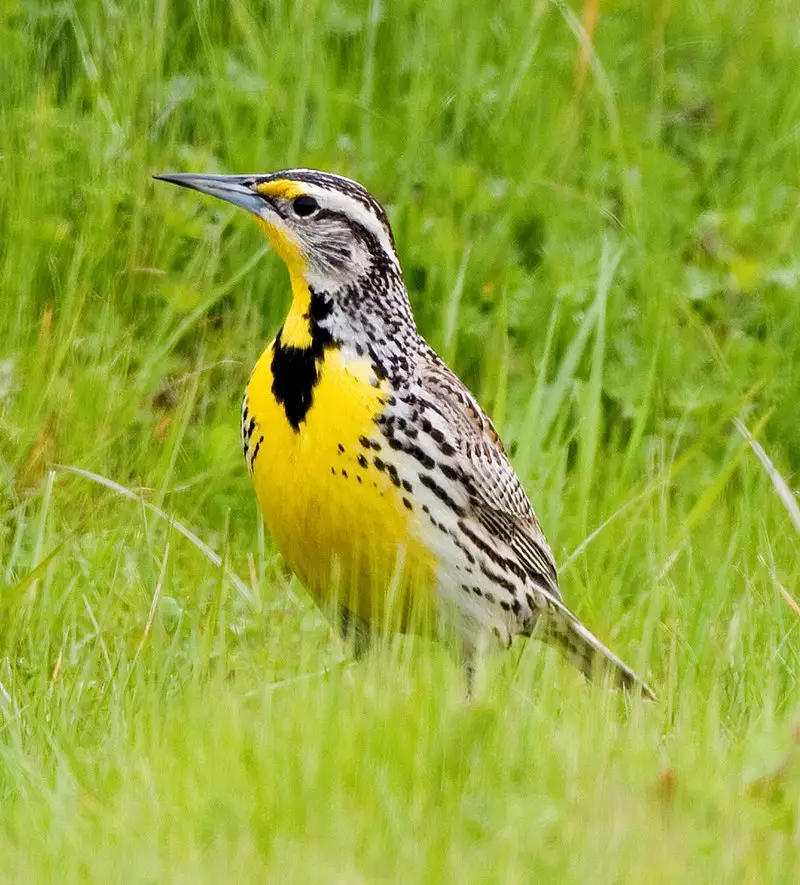
The western meadowlark is a medium-sized icterid bird native to North America. It has a distinct yellow breast with black and white patches, making it easy to spot in open grasslands.
Its diet consists of mostly bugs but also includes seeds and berries. The western meadowlark’s call is unique – its sound described as flute-like or watery, differentiating it from the similar eastern meadowlark species.
When nesting season arrives, they build their nests on the ground near shrubs or low trees in areas like fields and pastures.
This beautiful songbird adds life to our open lands with its melodious tunes.Scientific classification:
| Kingdom | Animalia |
| Phylum | Chordata |
| Class | Aves |
| Order | Passeriformes |
| Family | Icteridae |
| Genus | Sturnella |
| Species | S. neglecta |
5. Black-Capped Chickadee
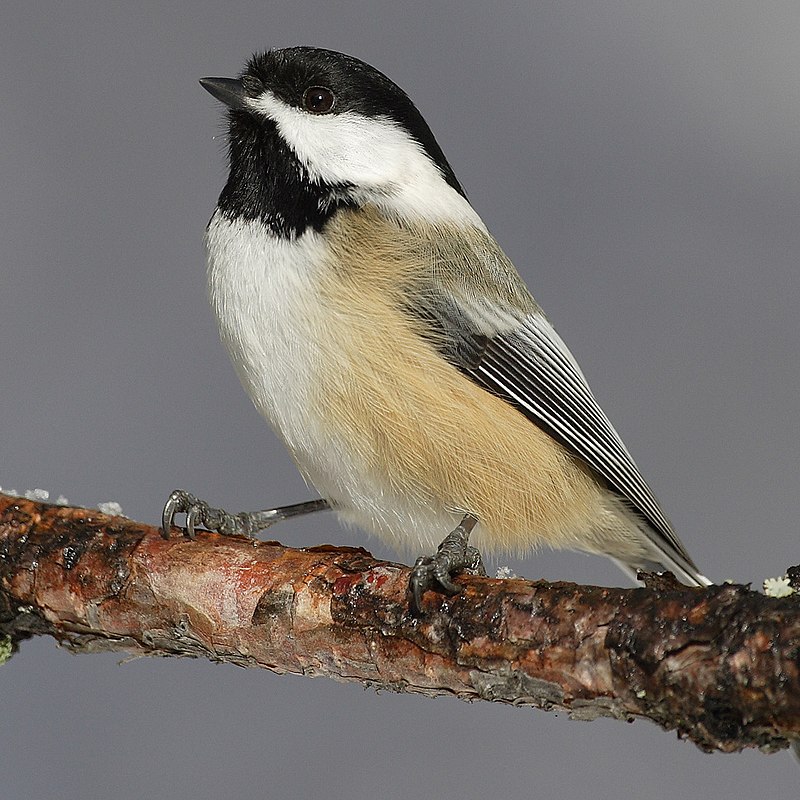
The black-capped chickadee is a small and cheerful songbird found in deciduous and mixed forests across North America. It has an iconic black cap, white cheeks, gray back and wings with whitish bars on them.
The underparts are usually light colored or greyish brown. This species is well adapted to cold winters as it can reduce its body temperature by up to 8°C while roosting at night; this helps save energy during the colder months of the year.
It feeds mainly on insects but also eats seeds, fruits and suet from bird feeders when available.
Black-capped chickadees are popular birds among backyard visitors due to their sociable nature – they often establish lifelong partnerships with one another for breeding purposes.
Furthermore, they have been designated as state birds of Massachusetts and Maine in USA plus New Brunswick in Canada – a testament to how beloved these little avian friends truly are.Scientific classification:
| Kingdom | Animalia |
| Phylum | Chordata |
| Class | Aves |
| Order | Passeriformes |
| Family | Paridae |
| Genus | Poecile |
| Species | P. atricapillus |
6. Downy Woodpecker
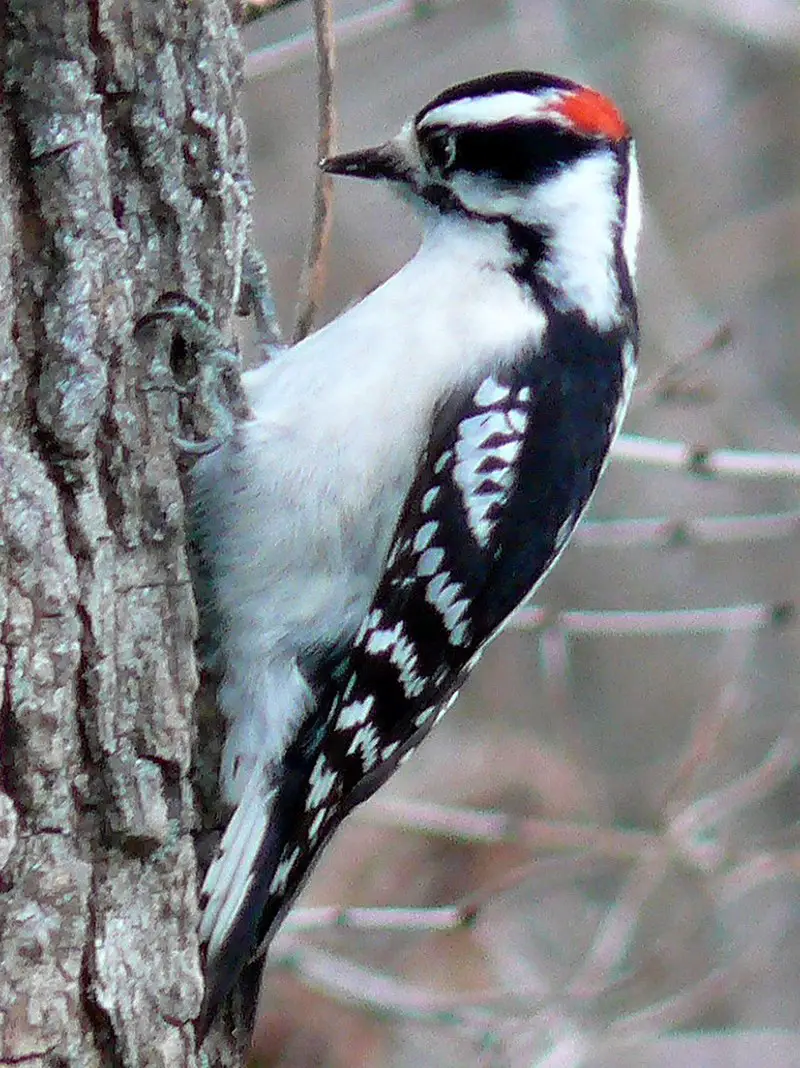
The downy woodpecker is a small species of woodpecker found in North America. Growing up to 7 inches long, it can be identified by its white belly and spotted wings.
It inhabits forests throughout the United States and Canada, with the exception of deserts in the southwest and northern tundra.
This bird nests in tree cavities and feeds mostly on insects but will supplement its diet with fruit or nuts when available.
The Downy Woodpecker has an unmistakable call that sounds like a loud ‘pik-er’, similar to other members of its family such as the Hairy Woodpecker.Scientific classification:
| Kingdom | Animalia |
| Phylum | Chordata |
| Class | Aves |
| Order | Piciformes |
| Family | Picidae |
| Genus | Dryobates |
| Species | D. pubescens |
7. House Finch

The House Finch is a species of finch native to western North America and has been introduced in the eastern half of the continent as well as Hawaii.
It’s an average-sized finch with adults measuring 12.5 – 15 cm (5 – 6 inches) long and having wingspans between 20 – 25 cm (8 – 10 inches).
The upperparts are brown, while its underparts range from pale grayish white to yellow depending on subspecies.
Its face is streaked or spotted with reddish coloration; males typically have brighter plumage than females due to sexual dimorphism.
They’re mostly found near human habitations such as farms and gardens where they feed on grains, fruits, insects etc., making them very popular among birders who want something colorful for their backyard.Scientific classification:
| Kingdom | Animalia |
| Phylum | Chordata |
| Class | Aves |
| Order | Passeriformes |
| Family | Fringillidae |
| Subfamily | Carduelinae |
| Genus | Haemorhous |
| Species | H. mexicanus |
8. Common Grackle
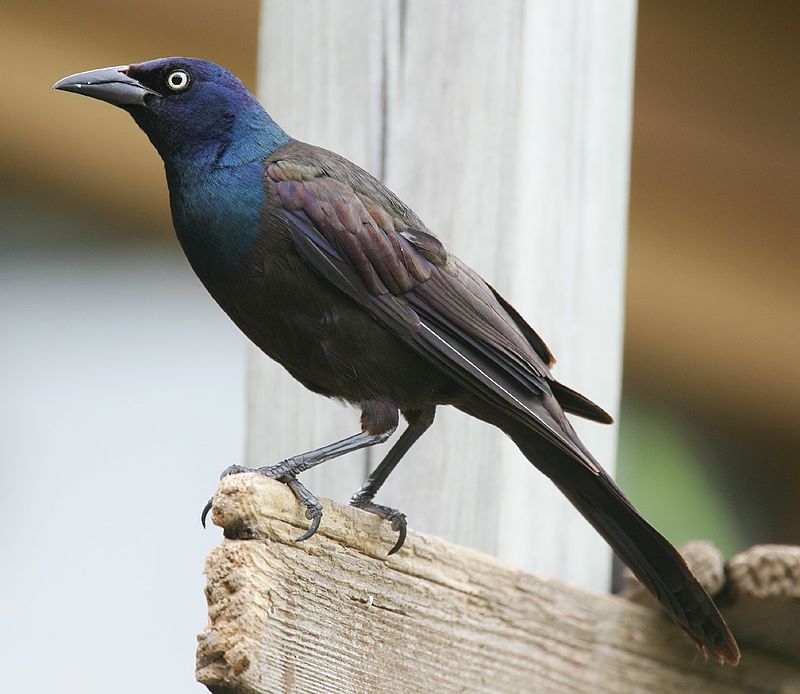
The Common Grackle is a large icterid bird commonly found in North America. It has an iridescent head and pale yellow eyes, which are framed by its long dark bill and long tail.
Males typically have more vivid colors on their heads than females do. These birds can be seen across much of the continent, in fields, forests, wetlands – even urban areas.
They form huge flocks to search for food such as grains or insects that they catch with their bills.
The grackles may also scavenge from human sources like garbage dumps or picnic tables if available. With its colorful plumage and distinct call it’s easy to spot this species amongst other birds.Scientific classification:
| Kingdom | Animalia |
| Phylum | Chordata |
| Class | Aves |
| Order | Passeriformes |
| Family | Icteridae |
| Genus | Quiscalus |
| Species | Q. quiscula |
9. Mourning Dove
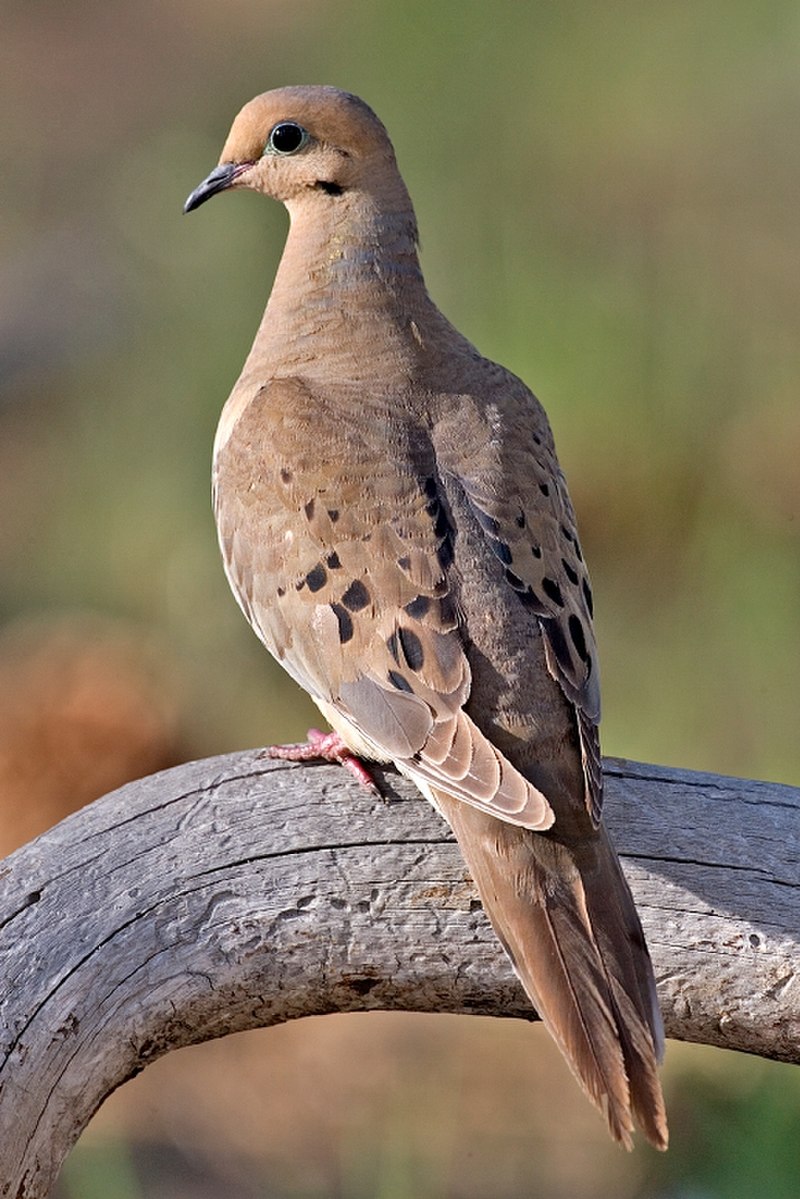
The Mourning Dove is a breathtakingly beautiful bird. It has stunning gray and brown feathers with white tipped wings, giving it an elegant appearance. Its long tail also adds to its graceful look in flight.
A symbol of peace and serenity, they are abundant across North America and can be found in gardens or open fields throughout the year.
As well as being popular game birds for hunters, they feed on grains such as wheat and millet providing important food sources for wildlife species including foxes, coyotes, skunks and raccoons.
These doves have a distinctive cooing sound that can often be heard echoing through woodlands during summer evenings making them one of nature’s greatest treasures.Scientific classification:
| Kingdom | Animalia |
| Phylum | Chordata |
| Class | Aves |
| Order | Columbiformes |
| Family | Columbidae |
| Genus | Zenaida |
| Species | Z. macroura |
10. Dark-Eyed Junco

The Dark-eyed Junco is a species of small, grayish sparrows that are found across much of temperate North America and in the Arctic during summer.
It was formally described by Carl Linnaeus in 1766, who named it after its distinctive dark eyes.
This bird has a very variable appearance due to the many different subspecies it contains, making its systematics difficult to unravel.
The plumage varies from white or light gray on their underparts with slate grey backs and wings; black heads with white outer tail feathers; brown head stripes; yellow bills; pink legs and feet; as well as various shades between all these colours.
They also have considerable sexual dimorphism where males tend to be more colourful than females but share similar characteristics such as short tails and rounded bodies – both sexes being around 16 cm long when fully grown.Scientific classification:
| Kingdom | Animalia |
| Phylum | Chordata |
| Class | Aves |
| Order | Passeriformes |
| Family | Passerellidae |
| Genus | Junco |
| Species | J. hyemalis |
11. Sandhill Crane
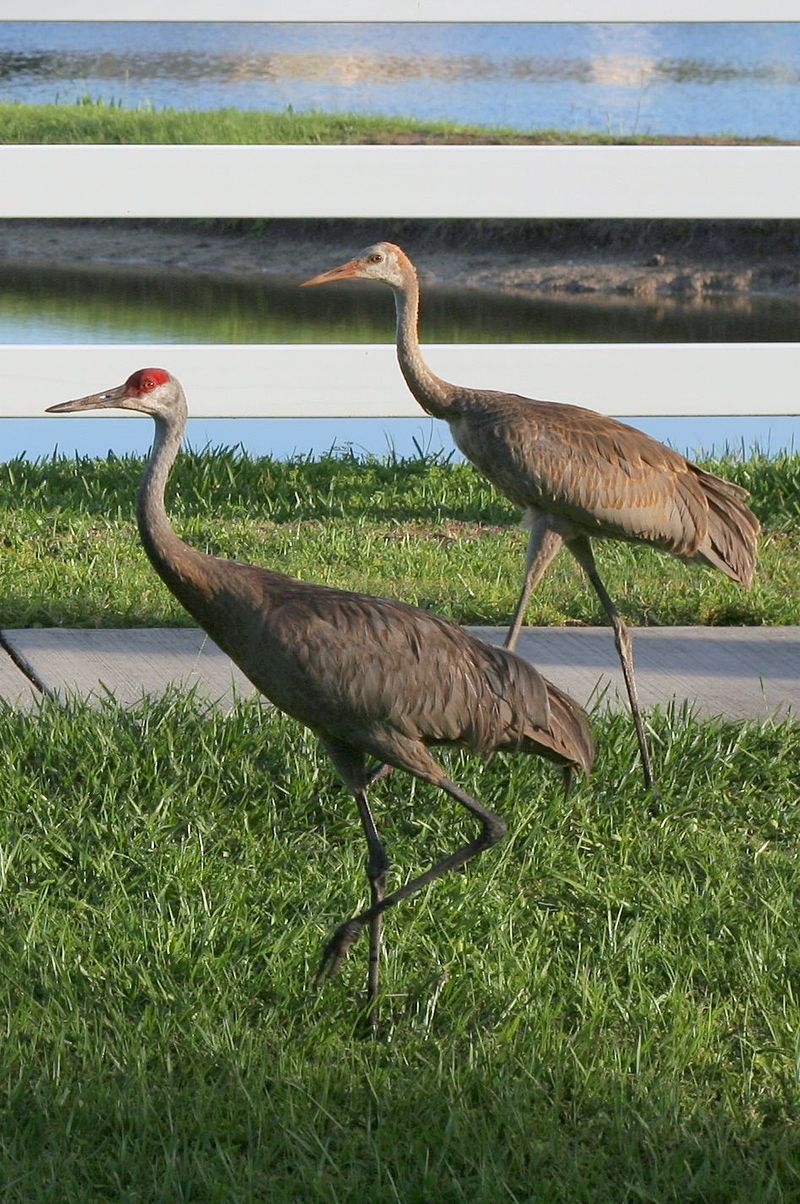
Sandhill Cranes are a large species of crane native to North America and northeastern Siberia. They are known for their distinctive calls, long legs, and long necks.
These birds typically inhabit wetland areas like the Platte River in Nebraska’s Sandhills on the Great Plains.
In Central Florida, they often gather at the edges of bodies of water such as lakes or rivers.
During breeding season, sandhill cranes can be seen performing elaborate courtship dances that involve bowing and jumping in unison with their partner.
Their diet consists mainly of plant material including grains, roots, tubers and aquatic plants which they obtain by pecking or digging into mudflats using their bill or feet respectively.
With an average lifespan between 10-20 years these majestic creatures make great additions to any wetland habitat.Scientific classification:
| Kingdom | Animalia |
| Phylum | Chordata |
| Class | Aves |
| Order | Gruiformes |
| Family | Gruidae |
| Genus | Antigone |
| Species | A. canadensis |
12. White-Breasted Nuthatch
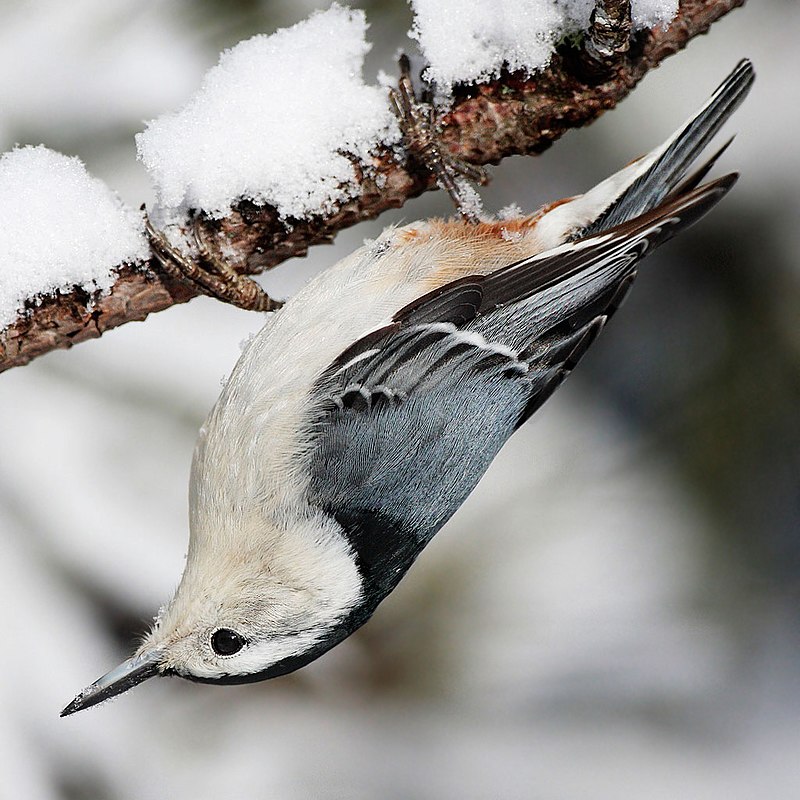
The White-breasted Nuthatch is a medium-sized bird belonging to the nuthatch family Sittidae. It measures around 15.5 cm in length and its colour varies throughout its range.
Males have a light blue-grey upperpart, with black crown and nape whereas females have a dark grey crown instead of black one.
The underparts are whitish, with reddish tinge on sides and flanks while the bill is short and stout with pale base near eyes which can be yellow or white depending upon geographic location..
This species feeds mainly on insects but will also eat seeds, nuts and berries when available.
They prefer open woodlands where they often climb trees searching for food along trunks as well as branches underneath bark crevices creating their nest there too.Scientific classification:
| Kingdom | Animalia |
| Phylum | Chordata |
| Class | Aves |
| Order | Passeriformes |
| Family | Sittidae |
| Genus | Sitta |
| Species | S. carolinensis |
13. Red-Winged Blackbird

The red-winged blackbird is a beautiful bird found in most of North America and Central America.
Its distinct features include a glossy black body, with white shoulder patches and bright red wing coverts year round.
It prefers wetland habitats such as marshes, ponds, lakeshores and agricultural fields. During breeding season they inhabit grassy areas near water then move south for the winter months.
For food they mainly eat insects but also consume wild fruit or grains.
They are very social birds often seen in large flocks during migration times when their unmistakable “conk-la-ree” call can be heard echoing across the sky.Scientific classification:
| Kingdom | Animalia |
| Phylum | Chordata |
| Class | Aves |
| Order | Passeriformes |
| Family | Icteridae |
| Genus | Agelaius |
| Species | A. phoeniceus |
14. Brown-Headed Cowbird
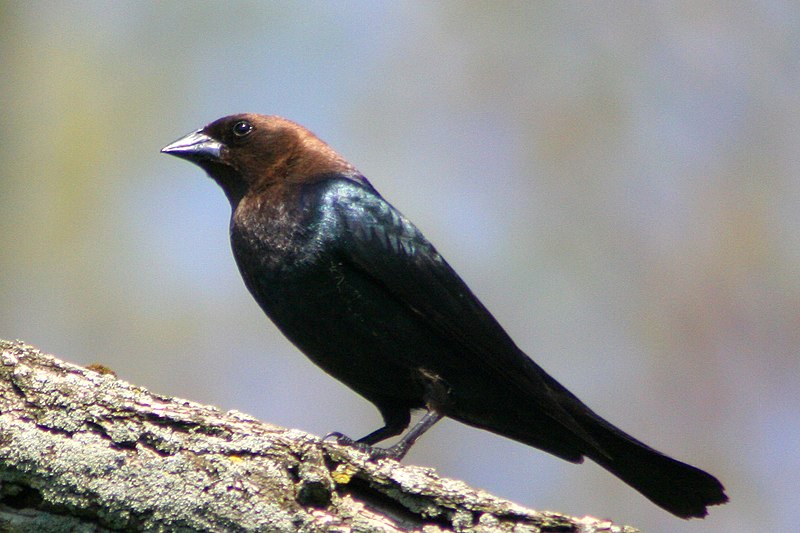
The Brown-headed Cowbird is a small, obligate brood parasitic icterid native to temperate and subtropical North America. It has a brown head with glossy black plumage on the body, wings and tail feathers.
During summer months it can be found in prairies, grasslands as well as open wooded areas but during winter they migrate southwards towards the United States of Mexico for warmer climate.
They are mainly insectivorous birds which feed on insects like caterpillars or beetles but also consume some grains too.
The female bird lays its eggs in nests of other species who then incubates them until hatching time thus leaving their own chicks uncared for by themselves.Scientific classification:
| Kingdom | Animalia |
| Phylum | Chordata |
| Class | Aves |
| Order | Passeriformes |
| Family | Icteridae |
| Genus | Molothrus |
| Species | M. ater |
15. House Wren
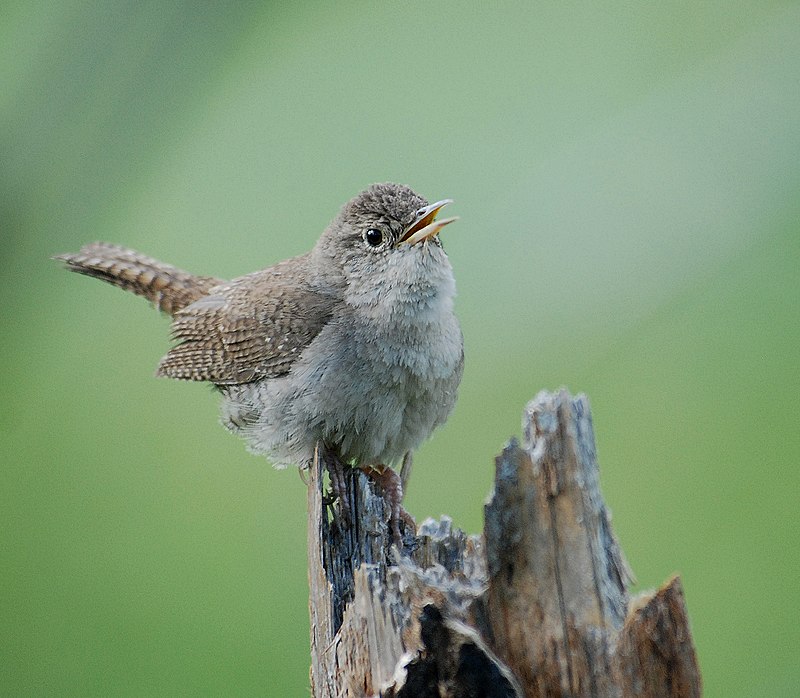
The House Wren is a small bird of the wren family found from Canada to South America. It’s quite common in suburban areas and is one of the most widely distributed native birds in North and South America.
Its taxonomy can be complicated, with some subspecies groups considered separate species.
The House Wren has a brown back, grey head, white eyebrow stripes, light chestnut belly and buffy flanks.
They often inhabit old or abandoned buildings as well as shrublands near fields or open woods for nesting sites.
During breeding season they are highly territorial so make sure you create an inviting environment if you wish to invite them into your yard.Scientific classification:
| Kingdom | Animalia |
| Phylum | Chordata |
| Class | Aves |
| Order | Passeriformes |
| Family | Troglodytidae |
| Genus | Troglodytes |
| Species | T. aedon |
16. American Yellow Warbler
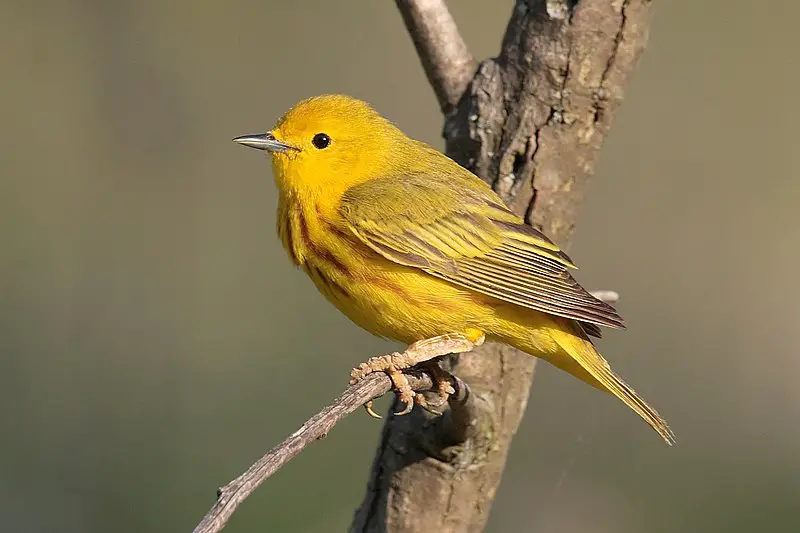
The American Yellow Warbler (Setophaga petechia) is a species of New World warbler found across North America, the Caribbean and into northern South America.
Its genus name Setophaga comes from Ancient Greek words meaning “moth” and “eating”, while its specific name Petechia originates from Italian for small red spots.
This bird has striking yellow plumage with reddish-brown streaks on their chest that can be seen during mating season when they are most colourful.
They live in open woodlands near wetlands or bodies of water where they can find food such as insects like spiders, beetles and caterpillars which make up much of their diet.
The male will sing to attract a mate during breeding season before setting up home in twig nests built by both sexes together high in trees or shrubs.Scientific classification:
| Kingdom | Animalia |
| Phylum | Chordata |
| Class | Aves |
| Order | Passeriformes |
| Family | Parulidae |
| Genus | Setophaga |
| Species | S. petechia |
17. Baltimore Oriole
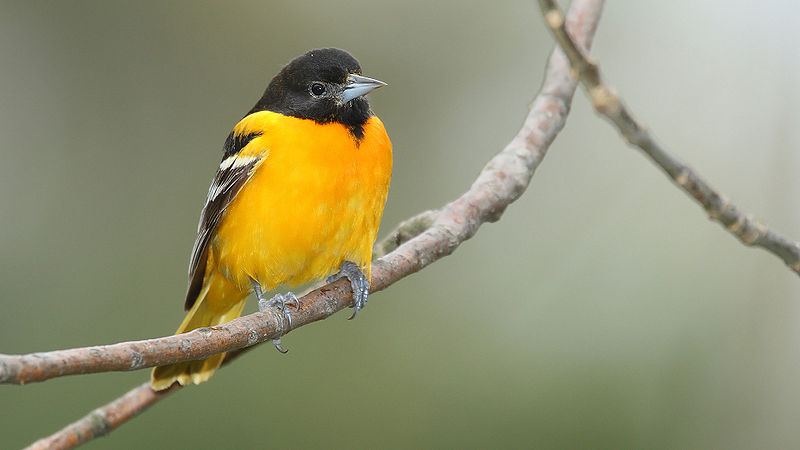
The Baltimore Oriole is a small, blackbird-like bird found in eastern North America. It’s named for the resemblance of its male colors to those on Lord Baltimore’s coat-of-arms from 17th century.
These birds migrate and breed during springtime and are quite common in their habitats.
Studies have shown that this species interbreeds with western Bullock’s orioles, leading both to be classified as a single species – Icterus galbula.
The males typically have orange feathers along the chest, back, wings and tail while females display tan or yellowish shades instead of bright orange ones like males do.
Both sexes share white wing bars and dark brown eyes which makes them easily distinguishable among other birds.
They can often be seen flitting around trees feeding off nectar buds or insects such as grasshoppers & caterpillars they catch while flying around.Scientific classification:
| Kingdom | Animalia |
| Phylum | Chordata |
| Class | Aves |
| Order | Passeriformes |
| Family | Icteridae |
| Genus | Icterus |
| Species | I. galbula |
18. Yellow-Headed Blackbird
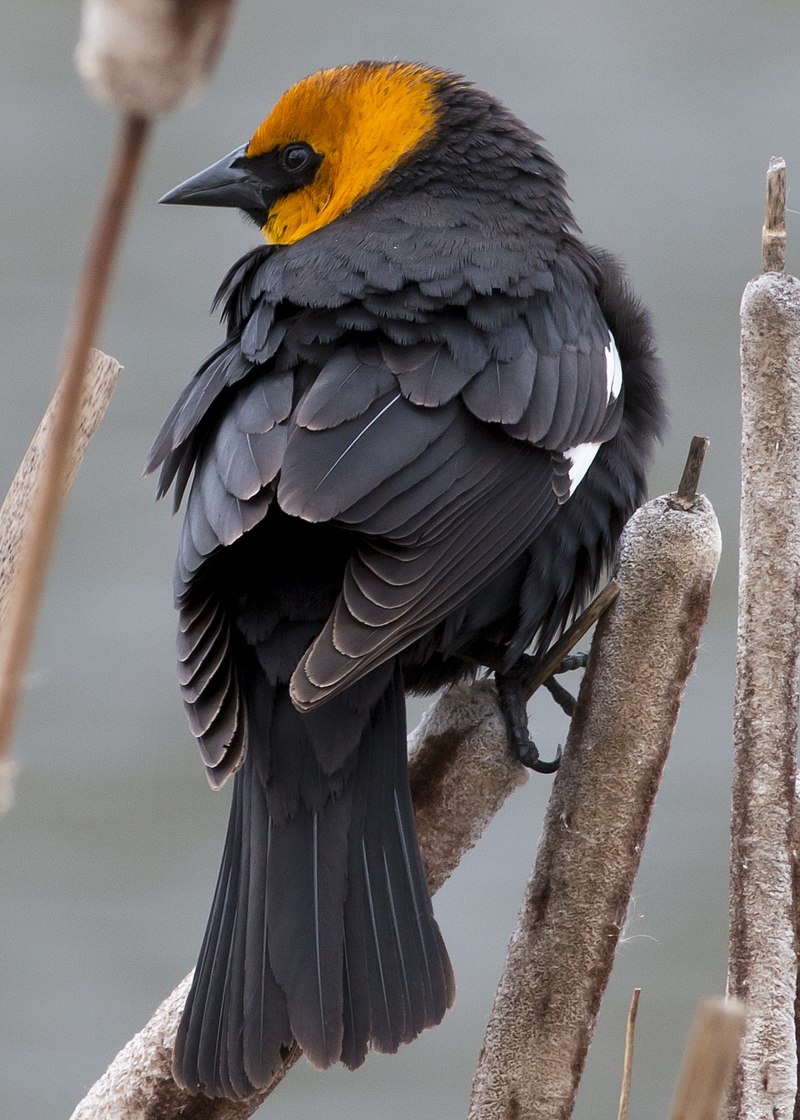
The yellow-headed blackbird is a medium-sized bird with striking features – its head and neck are bright yellow, while the rest of its body is black.
It has large eyes, a pointed bill and long wings that help it to soar through the air.
The species gets its name from Greek words meaning ‘yellow’ (xanthous) and ‘head’ (cephalus).
This species can be found in wetlands across North America during summer months where they feed on insects and other invertebrates such as snails, earthworms, spiders and crustaceans.
During winter months they migrate southward for food or when temperatures drop too low for their comfort.
They also form flocks which makes them more visible than solitary birds like hawks or owls. Yellow-headed Blackbirds make beautiful sounds that echo around wetland areas; these melodic calls bring joy to many nature lovers.Scientific classification:
| Kingdom | Animalia |
| Phylum | Chordata |
| Class | Aves |
| Order | Passeriformes |
| Family | Icteridae |
| Genus | Xanthocephalus Bonaparte, 1850 |
| Species | X. xanthocephalus |
19. American Crow
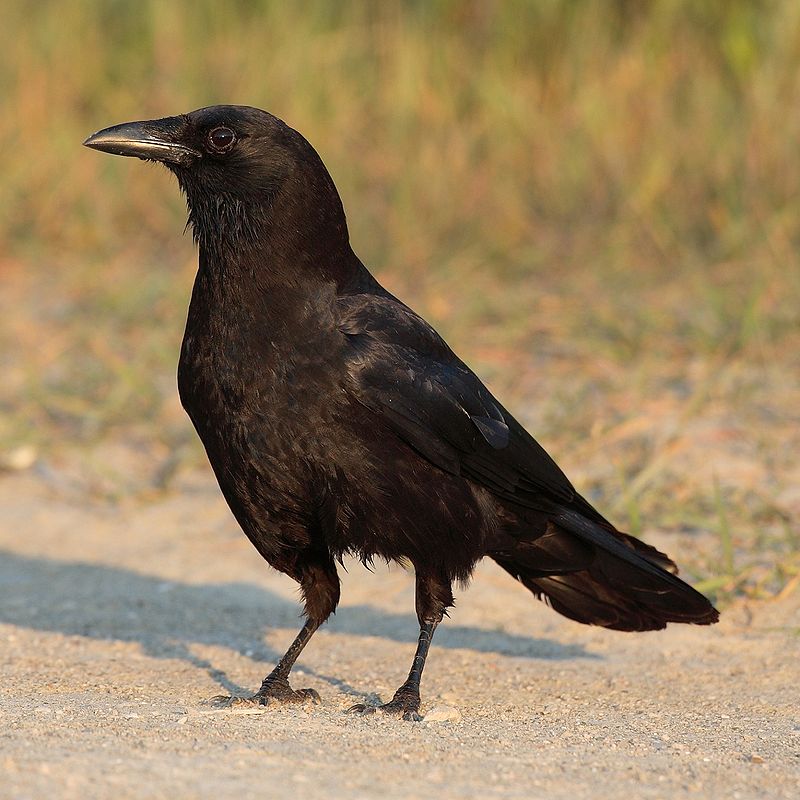
The American crow is a large bird of the Corvidae family, native to most parts of North America.
It is similar in size and structure to its European counterpart, the carrion crow, as well as Eurasia’s hooded crow.
The three species occupy the same ecological niche, but are distinguishable by their differences in appearance.
American crows have black feathers covering their entire body with wingspan averaging between 17-21 inches wide for males and 16-19 inches for females.
They feed on insects such as grasshoppers, beetles and caterpillars; they also eat grains from fields or abandoned farms during winter months when food sources become scarcer.
In addition to feeding habits American crows can be identified by their distinct call which resembles a “caw” sound that travels long distances over open terrain making them popular among birdwatchers.Scientific classification:
| Kingdom | Animalia |
| Phylum | Chordata |
| Class | Aves |
| Order | Passeriformes |
| Family | Corvidae |
| Genus | Corvus |
| Species | C. brachyrhynchos |
20. Yellow-Rumped Warbler
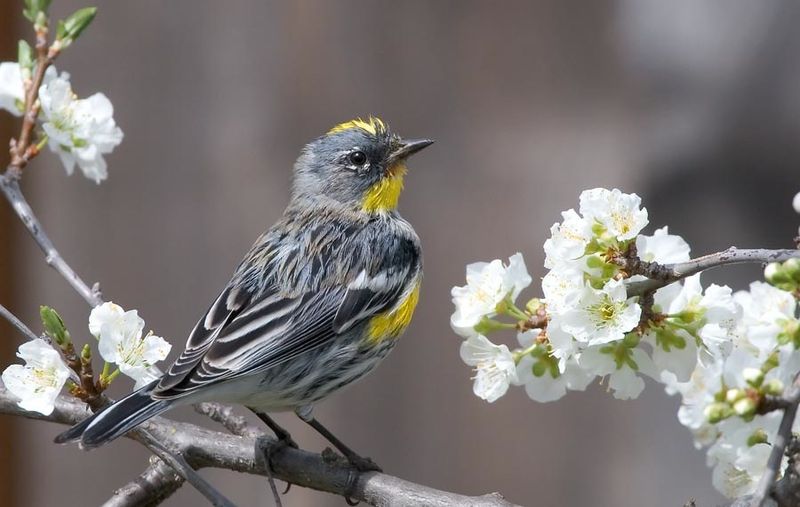
The Yellow-rumped Warbler (Setophaga coronata) is a migratory bird species that can be found throughout North America.
It has an extensive range, from the Pacific and Atlantic coats of the US to Canada and Central America, with a concentration in northern areas during breeding season.
These birds migrate southwards for wintering grounds where they find plentiful food sources such as insects and berries.
They are easily identified by their yellow patches on either side of their tails, along with white underparts, gray back feathers and two distinct crown stripes.
One black or greyish-brown above the eyes extending towards its neck banded in yellow or light brown colouration.
Furthermore, these warblers have strong legs which allow them to cling onto branches while hunting for prey making them adept at maneuvering through tree cover quickly.
All together this makes the Yellow-rumped Warbler an attractive backyard visitor year round.Scientific classification:
| Kingdom | Animalia |
| Phylum | Chordata |
| Class | Aves |
| Order | Passeriformes |
| Family | Parulidae |
| Genus | Setophaga |
| Species | S. coronata |
21. Orchard Oriole
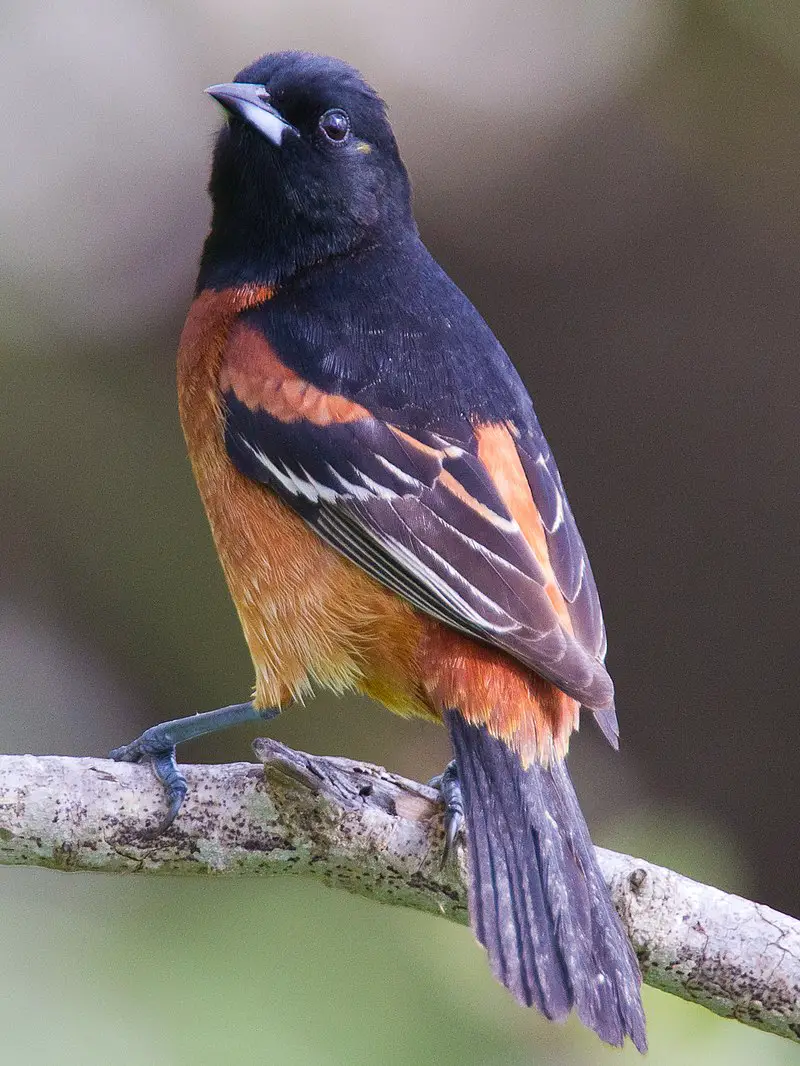
The Orchard Oriole is a small species of icterid bird, with the subspecies I. s. fuertesi sometimes considered its own separate species known as the Ochre or Fuertes’ Oriole.
The adult male of the nominate subspecies has chestnut upperparts and black wings and tail, while females are more yellowish-green in coloration on their back and wings.
Its bill is pointed, black in color with some blue-gray at the base of its lower mandible.
This beautiful bird can also be found across North America during migration season; they inhabit woodlands near streams or rivers to breed before migrating south for winter months.Scientific classification:
| Kingdom | Animalia |
| Phylum | Chordata |
| Class | Aves |
| Order | Passeriformes |
| Family | Icteridae |
| Genus | Icterus |
| Species | I. spurius |
Also Featured In: Birds Live in Arkansas, Birds in Iowa Spring
22. Red-Breasted Nuthatch
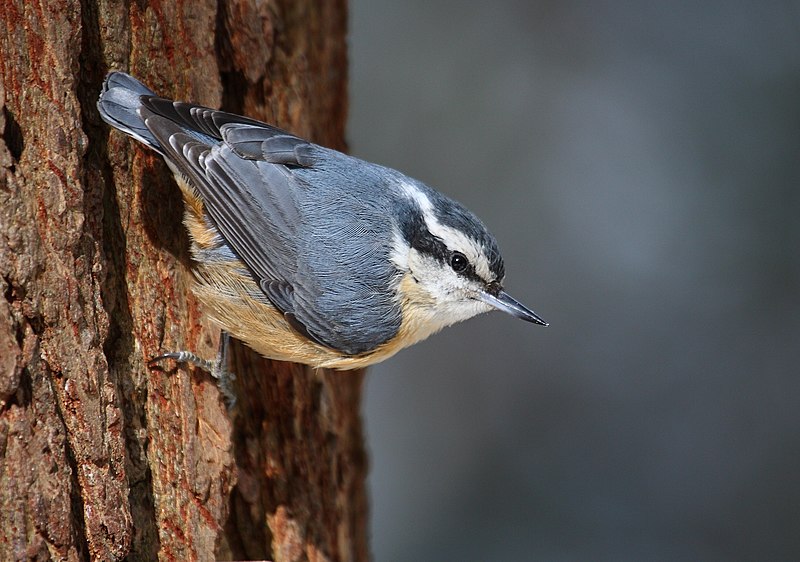
The Red-breasted Nuthatch is a beautiful and vocal songbird that can be found in coniferous forests across Canada, Alaska, the northeastern United States and western US.
This small bird has blue-grey upperparts with cinnamon underparts, a white throat and face with black eye stripe, straight grey bill and black crown.
Its call sounds like a tin trumpet; it’s high-pitched yet nasal.
During mating season they form monogamous pairs to build their nest near tree trunks or branches at low heights off the ground where they lay 2 – 8 eggs at once.
They are very active little birds who love clinging to trees while searching for insect larvae or seeds within the bark of trees which helps control pest populations.Scientific classification:
| Kingdom | Animalia |
| Phylum | Chordata |
| Class | Aves |
| Order | Passeriformes |
| Family | Sittidae |
| Genus | Sitta |
| Species | S. canadensis |
23. Red-Bellied Woodpecker
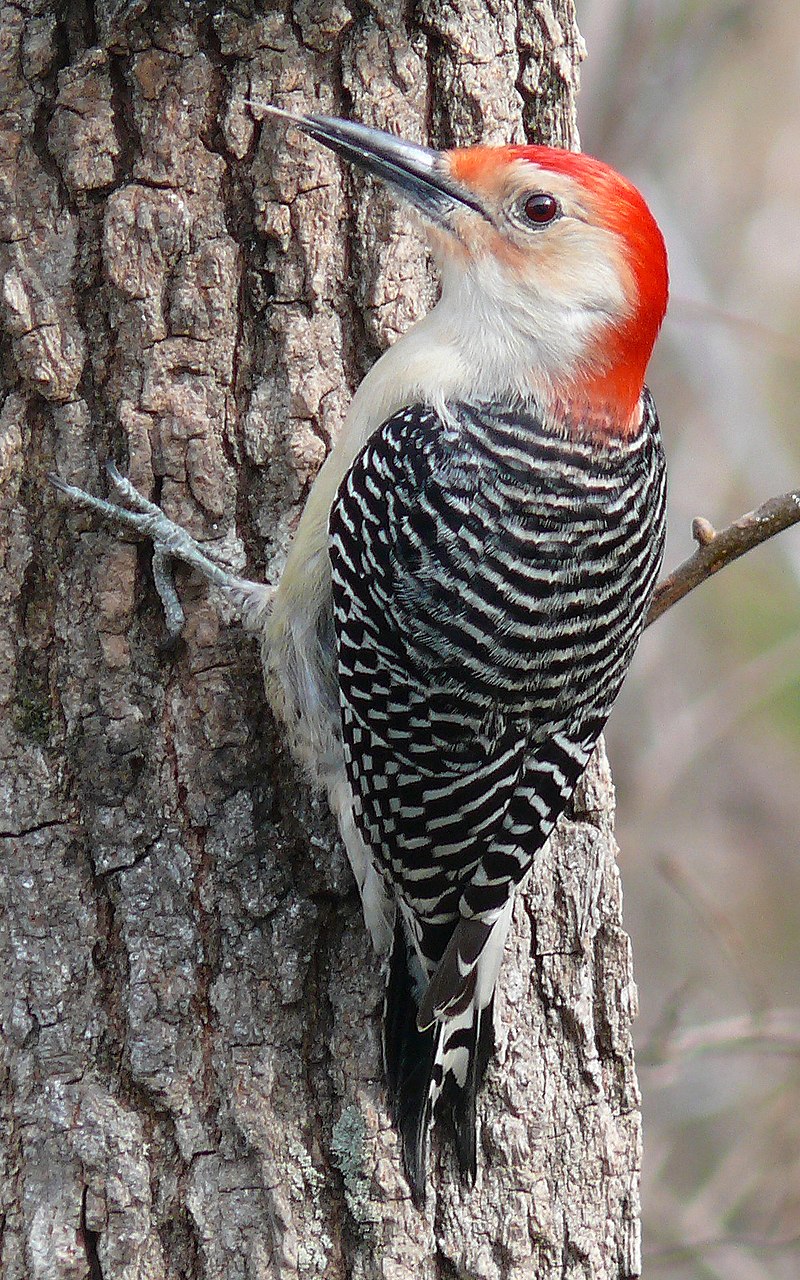
The Red-bellied woodpecker is a beautiful bird with an orange-red crown and nape. It breeds mainly in the eastern United States, ranging from Florida to Canada.
This medium-sized woodpecker of the family Picidae has black wings, white stripes on its back and tail feathers that are barred with black.
Its underside is mostly pale yellow or white but it also features some red coloration around its neck area.
Despite this subtle red hue, it should not be mistaken for the entirely red head and neck belonging to the Red-headed woodpecker of the same genus Melanerpes carolinus.
The Red bellied Woodpeckers diet consists primarily of insects such as ants, beetles and grasshoppers along with nuts fruits berries and tree sap which they will feed upon during different times throughout their life cycle.Scientific classification:
| Kingdom | Animalia |
| Phylum | Chordata |
| Class | Aves |
| Order | Piciformes |
| Family | Picidae |
| Genus | Melanerpes |
| Species | M. carolinus |
24. Dickcissel
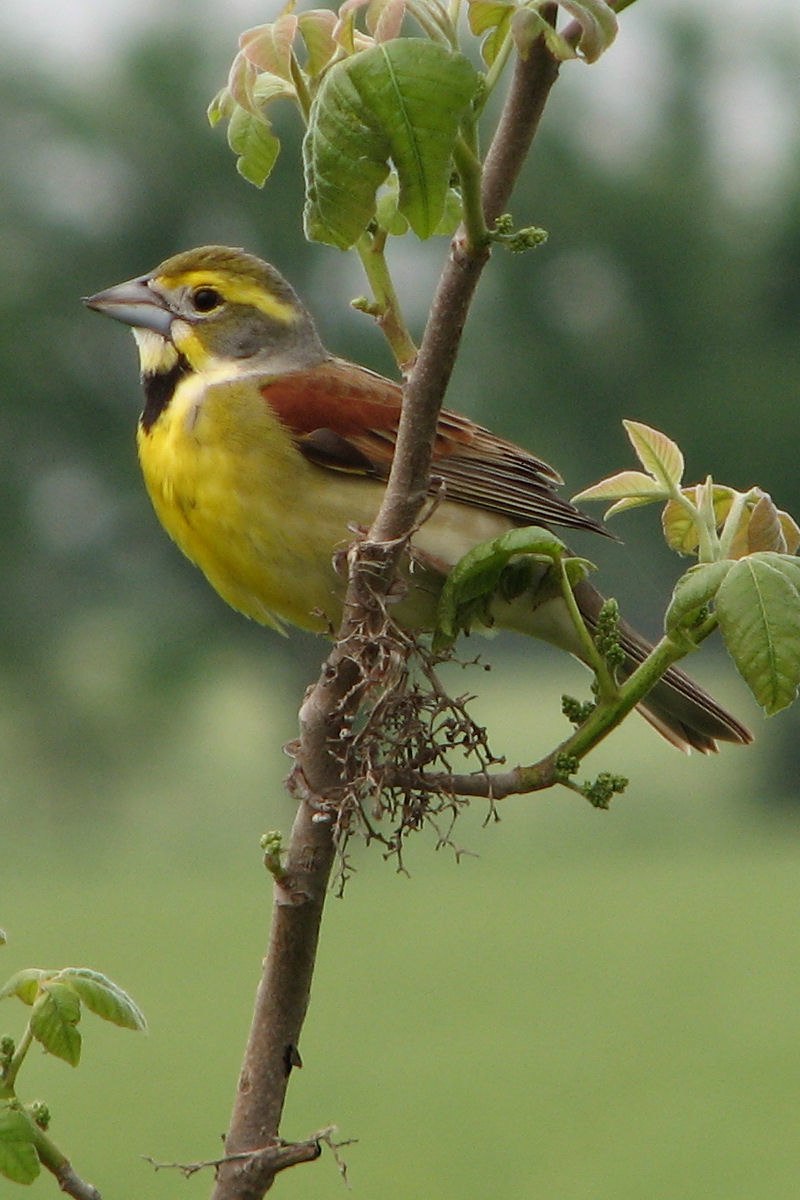
The Dickcissel is a small migratory bird belonging to the Cardinalidae family. It breeds in grasslands of the Midwestern US, and winters in Central America, northern Colombia and Venezuela.
Being the only member of its genus Spiza, it stands out from other birds with its distinctive song that sounds like “dick-sis-sel”.
With a light brown body and black streaks on its wings as well as chestnut colored shoulders and crowns, these birds are quite attractive to watch.
They also have short bills which they use while foraging through tall prairie vegetation or searching around fence posts for insects.
Although not endangered yet, their population has declined due to loss of habitat caused by human development so conservation efforts should be taken up soon.Scientific classification:
| Kingdom | Animalia |
| Phylum | Chordata |
| Class | Aves |
| Order | Passeriformes |
| Family | Cardinalidae |
| Genus | Spiza Bonaparte, 1824 |
| Species | S. americana |
25. Eastern Bluebird
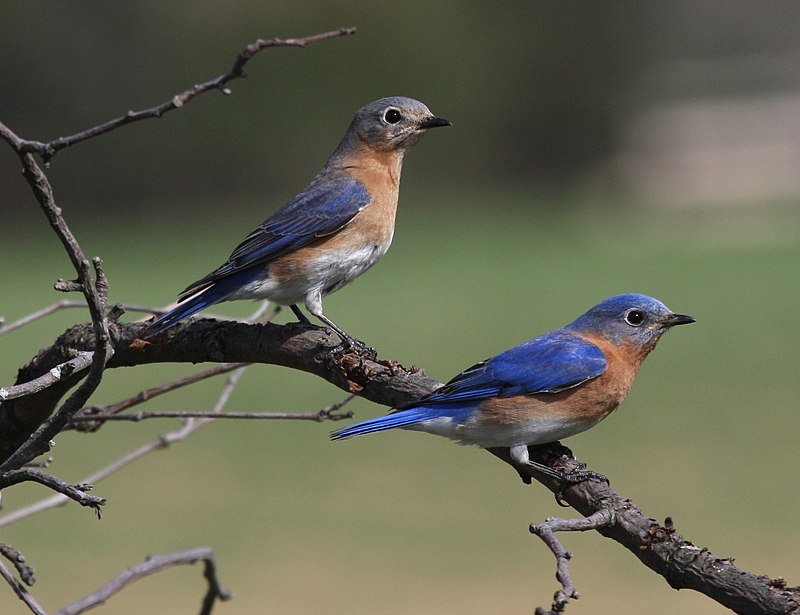
The Eastern bluebird is a small migratory thrush that can be found in open woodlands, farms and orchards across North America.
The male has bright-blue breeding plumage which makes it easily recognizable by birders.
It produces melodious songs such as jeew, chir-wi and chiti WEEW wewidoo.
This popular species was declared the state bird of Missouri back in 1927 due to its beauty and charm.
In addition to being beautiful, these birds are also beneficial for farmers because they eat insects like grasshoppers and beetles which damage crops.
They nest in cavities so providing nesting boxes helps them thrive even more.
With their vibrant colors, sweet melodies and helpful nature it’s easy to see why the Eastern Bluebird is beloved worldwide.Scientific classification:
| Kingdom | Animalia |
| Phylum | Chordata |
| Class | Aves |
| Order | Passeriformes |
| Family | Turdidae |
| Genus | Sialia |
| Species | S. sialis |
26. Chipping Sparrow
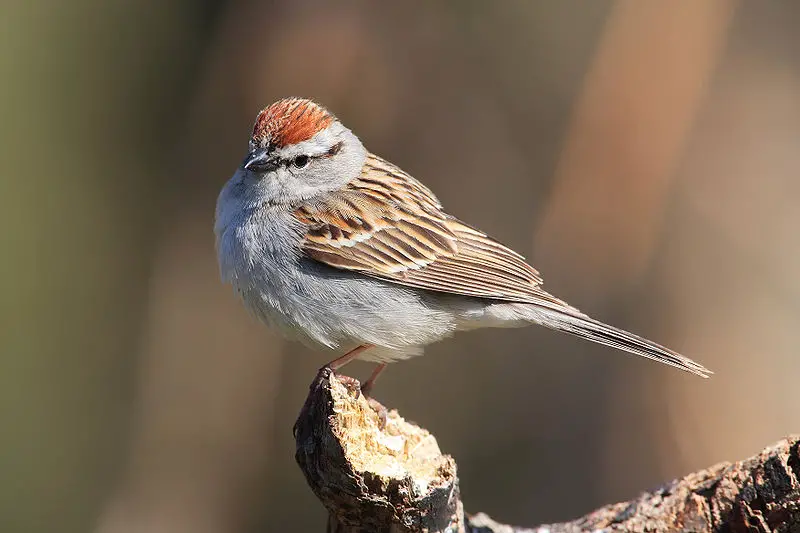
The Chipping Sparrow is a small passerine bird found across most of North America. It has two subspecies, the eastern and western chipping sparrows which migrate seasonally to overwinter in warmer climates.
The birds are grey above with white underparts, have a rufous cap with black stripes and large eyes surrounded by light brown feathers.
They feed mainly on seeds but can also be seen eating insects during breeding season when raising their young chicks.
These intrepid little birds live in open grasslands such as prairies or meadows where they build cup-shaped nests in trees or shrubs to raise their young family.
Their cheerful song often sounds like ‘chips’ hence its name; Chipping Sparrow.Scientific classification:
| Kingdom | Animalia |
| Phylum | Chordata |
| Class | Aves |
| Order | Passeriformes |
| Family | Passerellidae |
| Genus | Spizella |
| Species | S. passerina |
27. Gray Catbird
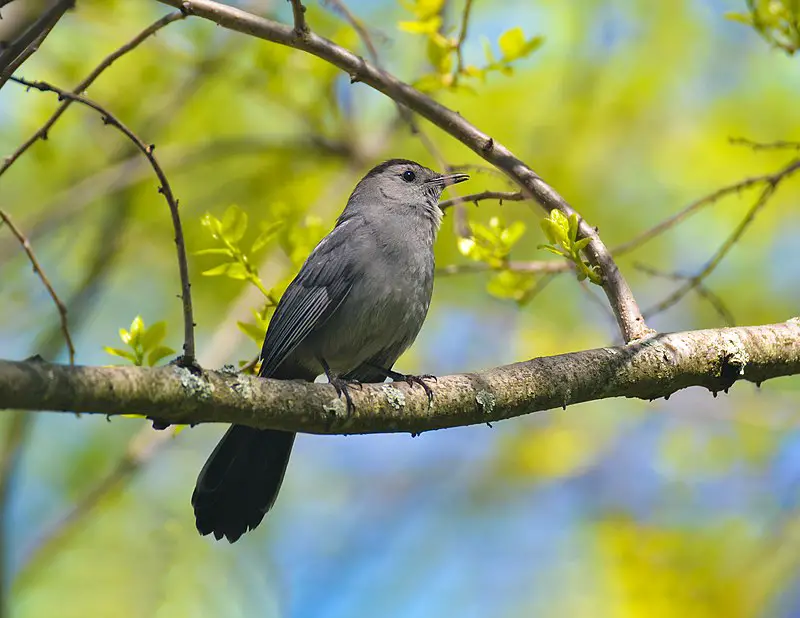
The Gray Catbird is a medium-sized bird native to North and Central America. It is the only species in its genus, Dumetella, which makes it unique among other perching birds of the Mimidae family.
Its plumage features shades of gray with some brownish tones on top and lighter grey below.
The underside of its tail has white feathers that contrast against their otherwise monochromatic coloration; this feature gives them their name as they often flick their tails when alarmed or excited like cats do.
They are omnivorous but mainly feed on insects such as caterpillars, grasshoppers, and beetles while also eating fruits like berries or cherries during summer months.
Despite being commonly seen alone or in pairs these birds will flock together at times for protection from predators like hawks who are drawn to their dark colouration against green foliage making them harder to spot.Scientific classification:
| Kingdom | Animalia |
| Phylum | Chordata |
| Class | Aves |
| Order | Passeriformes |
| Family | Mimidae |
| Genus | Dumetella C.T. Wood, 1837 |
| Species | D. carolinensis |
28. Song Sparrow
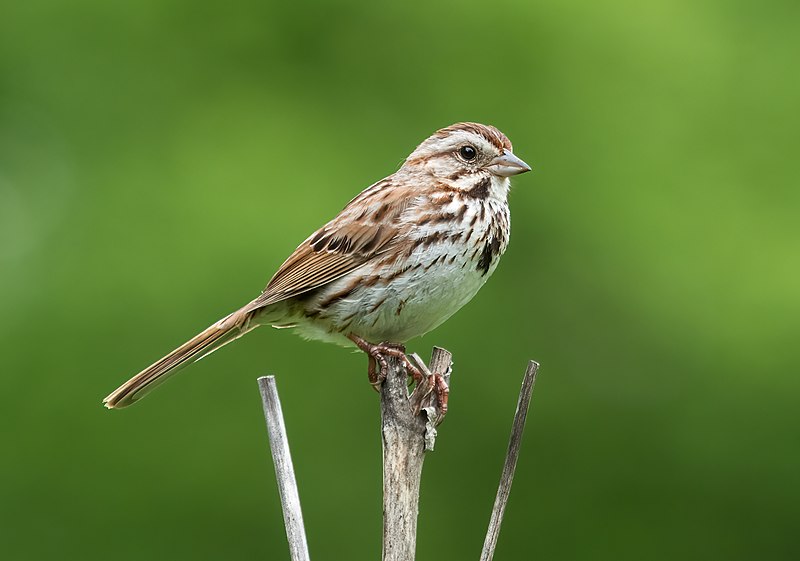
The Song Sparrow (Melospiza melodia) is a small, yet abundant bird found in North America.
They have brown upperparts with dark streaks and are white underneath, complete with a distinct dark brown spot on the breast.
Their cap is also brown and long roughed feathers can be seen sprouting from their neck area.
This sparrow species is highly variable and adaptable to many different environments including dry brush land, wetlands or open fields.
It has been noted that adult song sparrows will sing even during winter months when other birds remain quiet.
These energetic little animals make for great backyard companions as they flit about singing their lovely melodies.Scientific classification:
| Kingdom | Animalia |
| Phylum | Chordata |
| Class | Aves |
| Order | Passeriformes |
| Family | Passerellidae |
| Genus | Melospiza |
| Species | M. melodia |
29. Greater Prairie Chicken
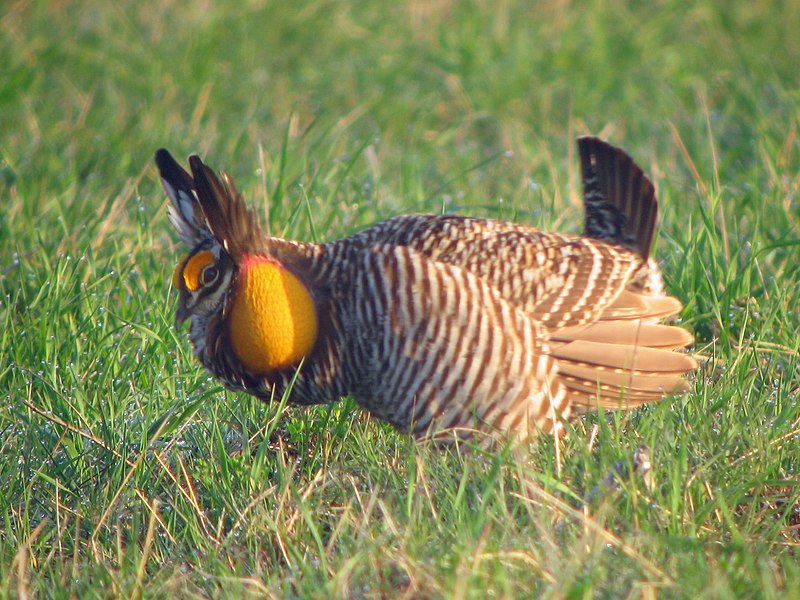
The Greater Prairie Chicken is a unique bird belonging to the grouse family. It was once extremely abundant across North America, with flocks seen in prairies and grasslands.
Sadly, because of habitat loss its population has drastically declined over time and it’s now considered endangered or extirpated in many areas.
To help ensure sustainability for these remaining populations, conservation efforts are being made.
The most remarkable feature of this species is their mating ritual called “booming”.
During breeding season males gather together on traditional booming grounds where they dance vigorously while producing loud sounds through inflatable air sacs located on either side of their necks – quite an impressive display.
Let us all work together to protect our natural world so that we can continue to enjoy these special creatures’ beauty and grace for generations to come.Scientific classification:
| Kingdom | Animalia |
| Phylum | Chordata |
| Class | Aves |
| Order | Galliformes |
| Family | Phasianidae |
| Genus | Tympanuchus |
| Species | T. cupido |
Also Featured In: Birds that Live in the Grasslands, Common Birds of Prairie
30. Western Kingbird
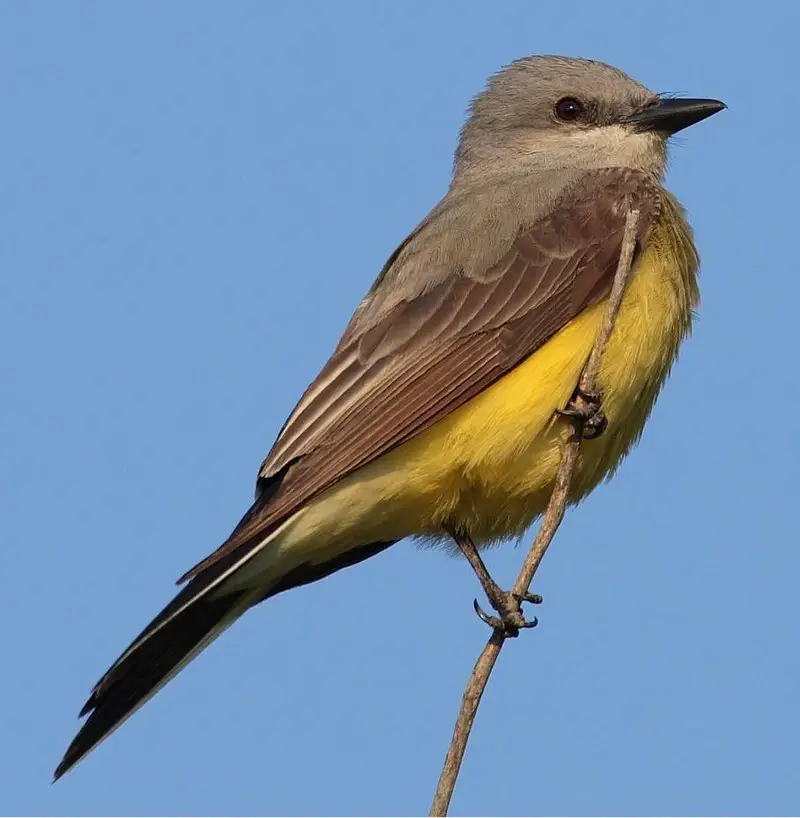
The Western kingbird is a large tyrant flycatcher native to western North America. It has striking plumage, with gray and yellow feathers tinged with crimson during courtship or when defending territory from intruders.
As is characteristic of its kind, the Western Kingbird exhibits highly territorial behavior towards other birds in its area.
They are found as far south as Mexico, inhabiting open habitats near bodies of water such as rivers and lakes.
While their primary diet consists of insects like bees and flies that they catch mid-flight, it also includes fruit for variety during winter months.
The species have recently seen an increase in population due to conservation efforts which aim to protect these beautiful creatures.Scientific classification:
| Kingdom | Animalia |
| Phylum | Chordata |
| Class | Aves |
| Order | Passeriformes |
| Family | Tyrannidae |
| Genus | Tyrannus |
| Species | T. verticalis |
31. Common Yellowthroat
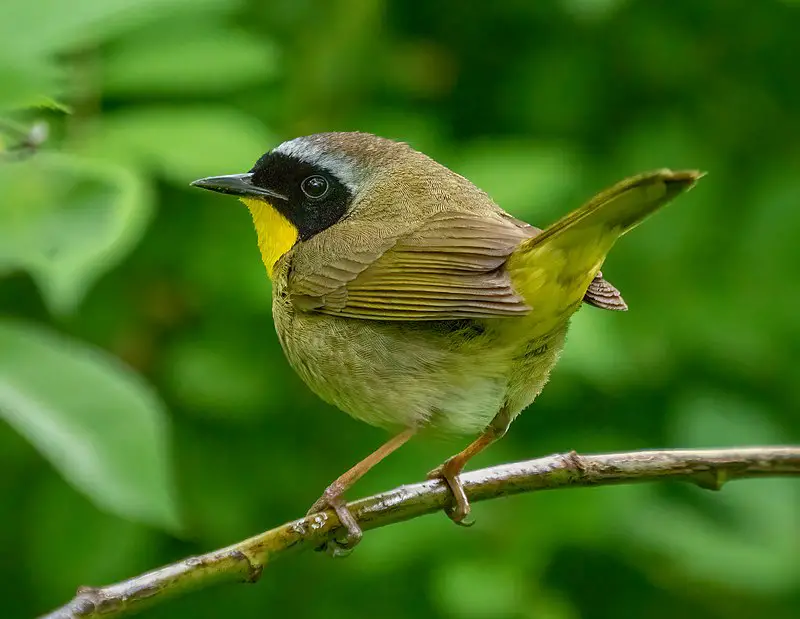
The Common Yellowthroat is a small, New World Warbler found throughout North America. It has distinctive yellow and black plumage that earned it the nickname “Yellow Bandit” in the Midwest United States.
This species is highly adaptable and can be found inhabiting wetlands, grasslands, shrub-land habitats, as well as suburban areas.
The genus of this bird’s scientific name translates to mean ‘ground’ and ‘small bird’, which are fitting characteristics for such an elusive yet common little creature.
Its diet consists predominantly of insects but may also include other invertebrates like spiders or worms.
Overall the Common Yellowthroat makes an excellent addition to any backyard with its cheerful song.Scientific classification:
| Kingdom | Animalia |
| Phylum | Chordata |
| Class | Aves |
| Order | Passeriformes |
| Family | Parulidae |
| Genus | Geothlypis |
| Species | G. trichas |
Also Featured In: Most Common Songs Birds that Live around You, Birds Commonly Found in New York
32. Eastern Meadowlark
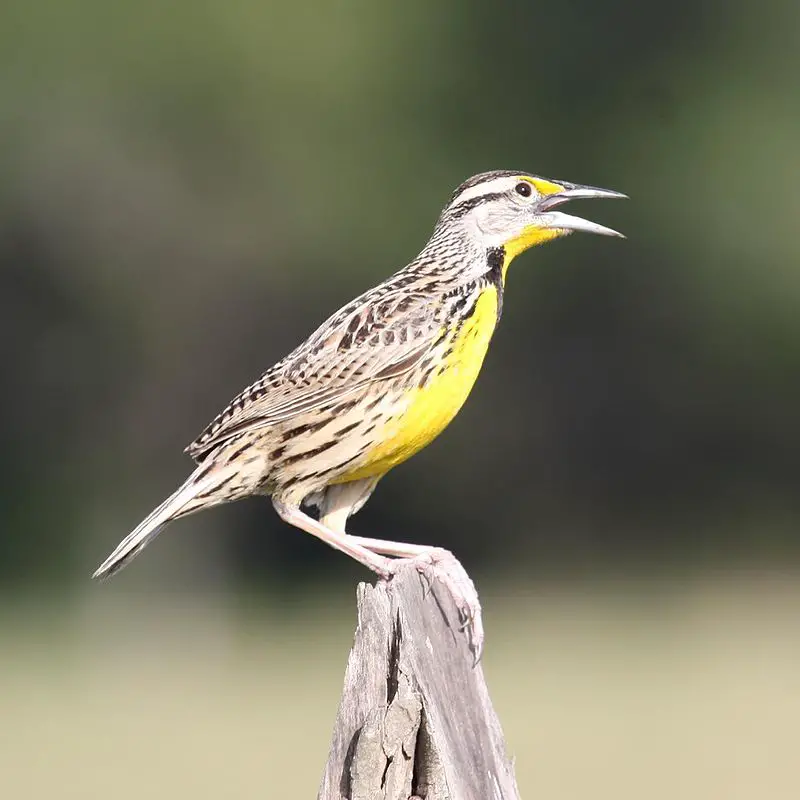
The Eastern meadowlark is a medium-sized blackbird, found from eastern North America to northern South America.
It used to be considered the same species as the Western meadowlark but has since been separated into its own distinct species.
The bird is mainly brown with yellow underparts and an orange patch on its throat; it also has white wing bars which can be seen in flight.
Its song consists of a series of musical whistles followed by gurgling notes at the end, earning them their nickname “rainmaker” birds because they are believed to bring rain if heard singing during dry weather.
These beautiful birds feed mostly on insects, seeds and other plant material while nesting amongst grasses or low shrubs near open fields where there’s plenty of food available for them.Scientific classification:
| Kingdom | Animalia |
| Phylum | Chordata |
| Class | Aves |
| Order | Passeriformes |
| Family | Icteridae |
| Genus | Sturnella |
| Species | S. magna |
33. Red-Tailed Hawk
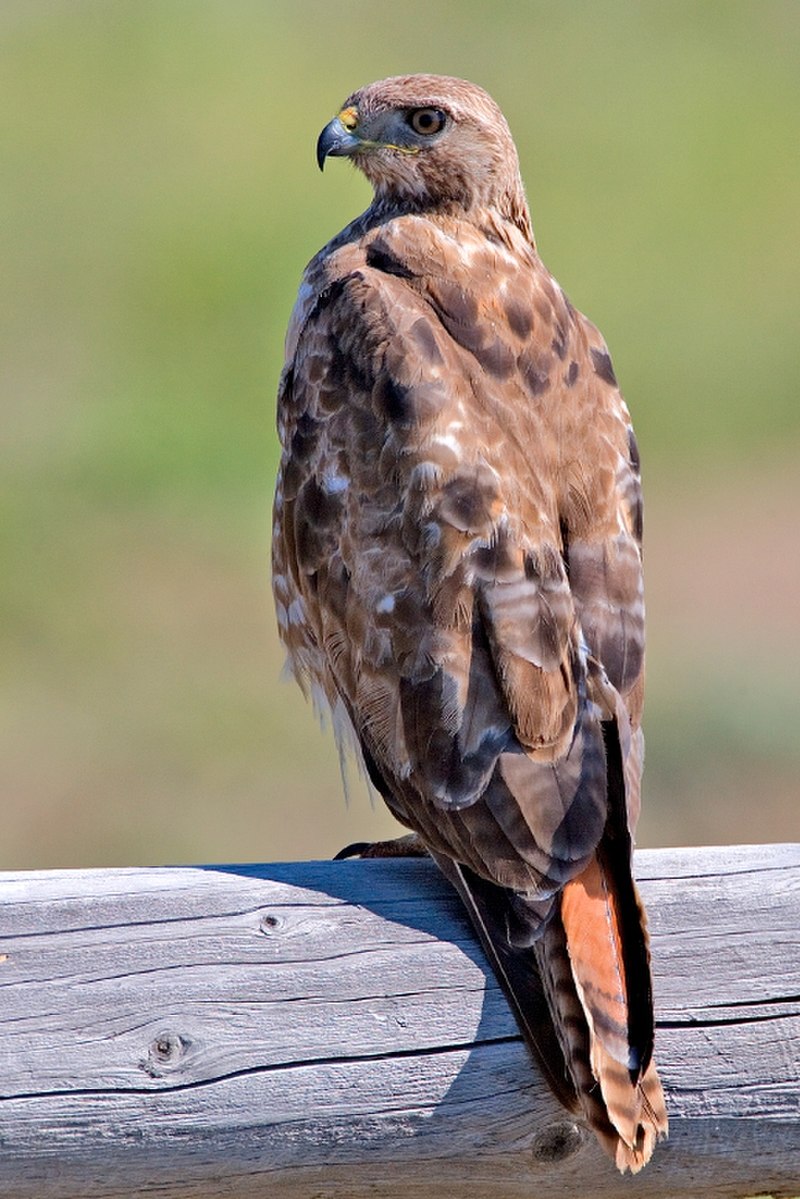
The Red-tailed Hawk is a majestic bird of prey with its distinctive red tail. It can be found throughout North America, from Alaska in the north to Panama and the West Indies in the south.
This species belongs to Buteo genus, which makes it one of most common raptors on earth.
These hawks mainly hunt small mammals such as rabbits or squirrels but also feed on reptiles and birds during migration season.
Unlike other predator birds, they prefer open areas for hunting like fields or grasslands rather than dense forests.
They build their nests high up on trees where they stay all year long unless disturbed by humans or animals nearby.
Their presence has become an iconic part of American culture due to their frequent sightings around homes and parks alike making them beloved creatures among people everywhere.Scientific classification:
| Kingdom | Animalia |
| Phylum | Chordata |
| Class | Aves |
| Order | Accipitriformes |
| Family | Accipitridae |
| Genus | Buteo |
| Species | B. jamaicensis |
34. Wilson’s Warbler
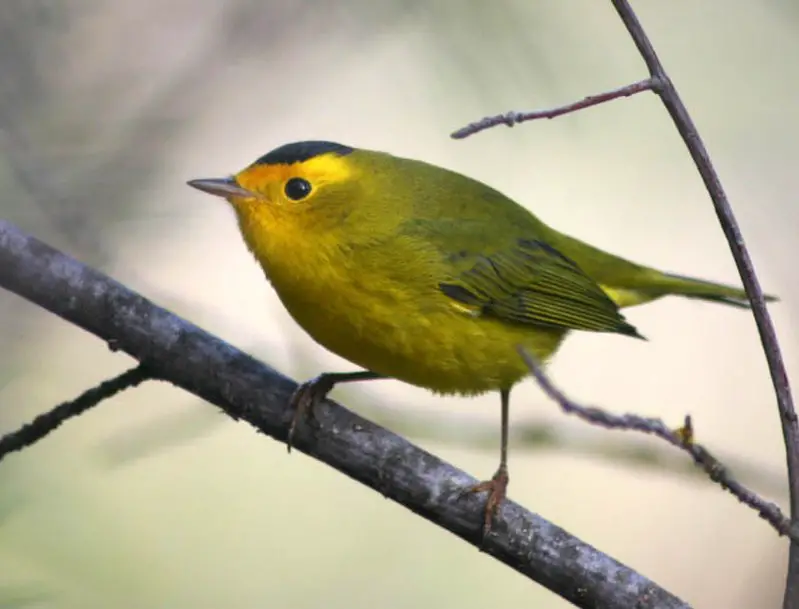
Wilson’s warbler is a small, brightly coloured bird found across North America. It has greenish upperparts and yellow underparts, with rounded wings and a long tail.
The male has an easily identifiable black crown patch which may or may not be present in the female depending on the subspecies.
They breed from Canada down to central parts of Mexico and then winter south through much of Central America.
These birds are usually seen flitting around low vegetation as they search for insects to eat – their main food source.
Their cheerful song can often be heard during spring migration when they travel back up north to breed again after spending winter further south.Scientific classification:
| Kingdom | Animalia |
| Phylum | Chordata |
| Class | Aves |
| Order | Passeriformes |
| Family | Parulidae |
| Genus | Cardellina |
| Species | C. pusilla |
Also Featured In: Common Birds in Saskatchewan, Common Yellow Birds of Idaho
35. Red-Headed Woodpecker
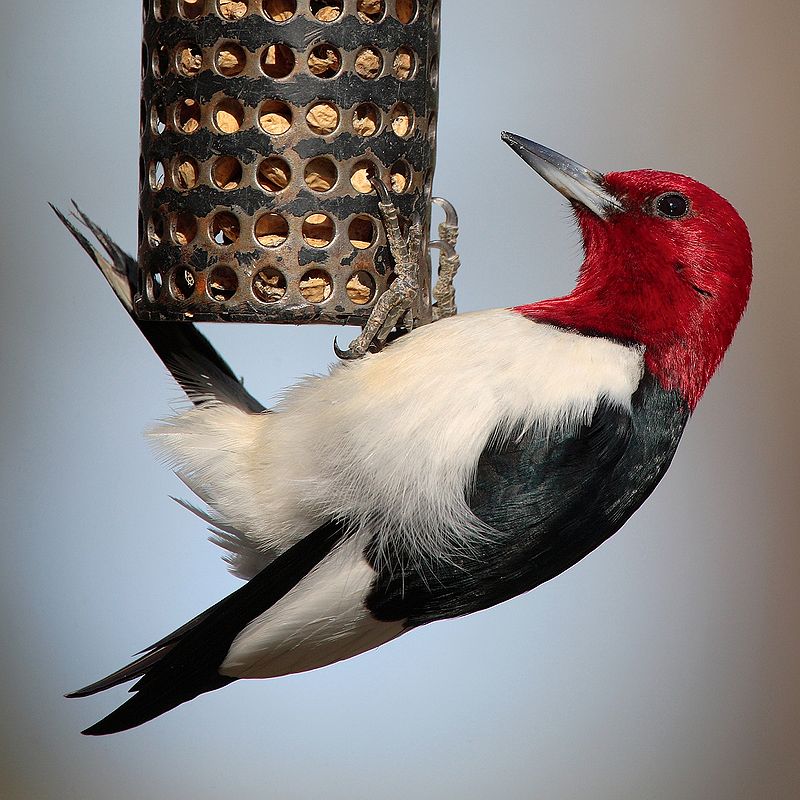
The red-headed woodpecker is a mid-sized bird found in temperate North America. It has striking plumage, with its head and neck being bright red while the rest of its body is primarily black and white.
Its wings are rounder than other similar species, allowing it to maneuver through tight spaces easily when searching for food or shelter.
The breeding habitat of this bird consists mainly of open fields across Canada and the east-central United States.
Despite facing threats such as deforestation, urbanization, predation from larger birds, collisions with windows or cars due to their inquisitive nature.
These birds remain listed on IUCN’s Red List as least concern thanks largely in part to conservation efforts by local governments and organizations dedicated to protecting wildlife habitats.Scientific classification:
| Kingdom | Animalia |
| Phylum | Chordata |
| Class | Aves |
| Order | Piciformes |
| Family | Picidae |
| Genus | Melanerpes |
| Species | M. erythrocephalus |
36. Loggerhead Shrike
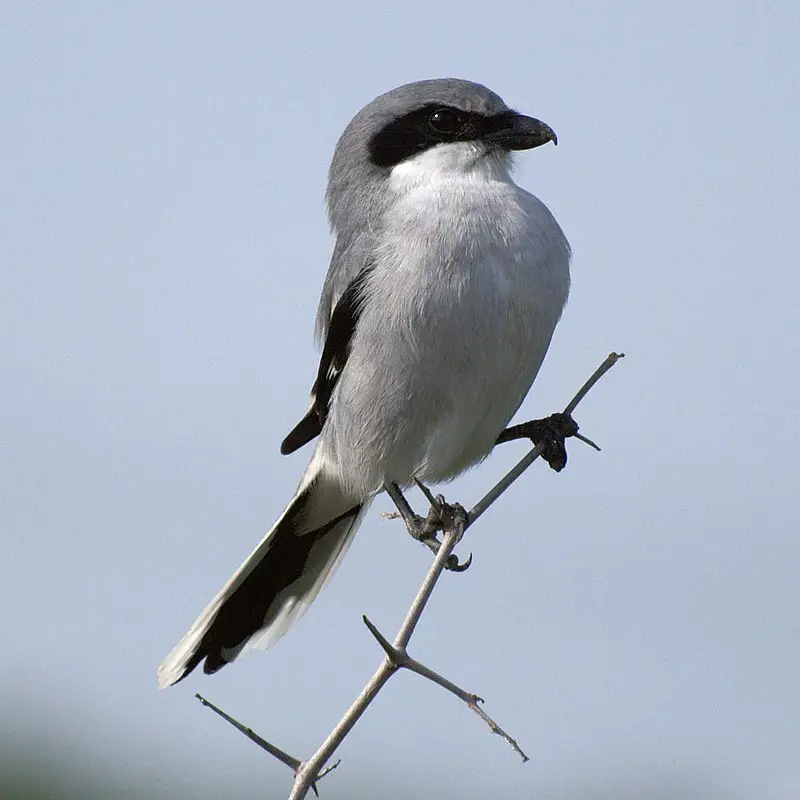
The Loggerhead Shrike is a carnivorous bird found only in North America. It belongs to the family Laniidae and is known as the “butcherbird” because of its habit of catching prey, such as amphibians, insects, lizards and small mammals.
The shrike has a black mask around its eyes and grey wings with white patches on them.
Its back is black with white spots that resemble stars or snowflakes; some individuals may have brown feathers instead of black ones.
This species feeds mainly by perching from elevated locations like bushes or trees where it can spot potential meals below it before diving down for capture.
Interestingly enough, these birds are also known to store their food by impaling it onto thorns which they use later when hungry.
With less than 2 million estimated population left in wild today this species needs our help so we should do whatever we can to protect them better.Scientific classification:
| Kingdom | Animalia |
| Phylum | Chordata |
| Class | Aves |
| Order | Passeriformes |
| Family | Laniidae |
| Genus | Lanius |
| Species | L. ludovicianus |
37. Rose-Breasted Grosbeak
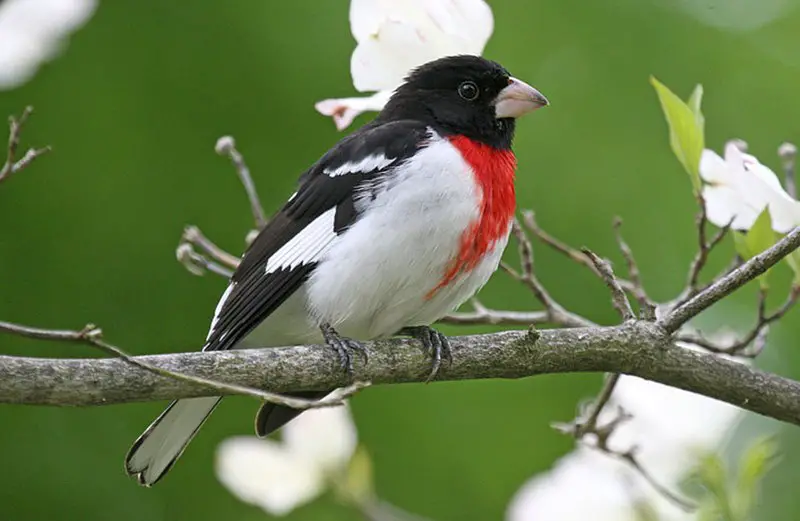
The Rose-breasted Grosbeak is a large, brightly coloured bird belonging to the Cardinal family. Males have black heads and wings, with white breasts boasting a bright rose patch.
Females are more muted in colouring being mostly buffy brown or greyish overall but still featuring the distinctive rose breast patch.The two sexes also exhibit marked sexual dimorphism.
These birds inhabit open woodlands across North America where they feed on seeds gleaned from foliage as well as fruits such as cherries and blueberries during their breeding season which runs from April through August each year.Scientific classification:
| Kingdom | Animalia |
| Phylum | Chordata |
| Class | Aves |
| Order | Passeriformes |
| Family | Cardinalidae |
| Genus | Pheucticus |
| Species | P. ludovicianus |
Also Featured In: New Hampshire Birds You Should Know, Summer Birds that Live around Us
38. Ruby-Throated Hummingbird
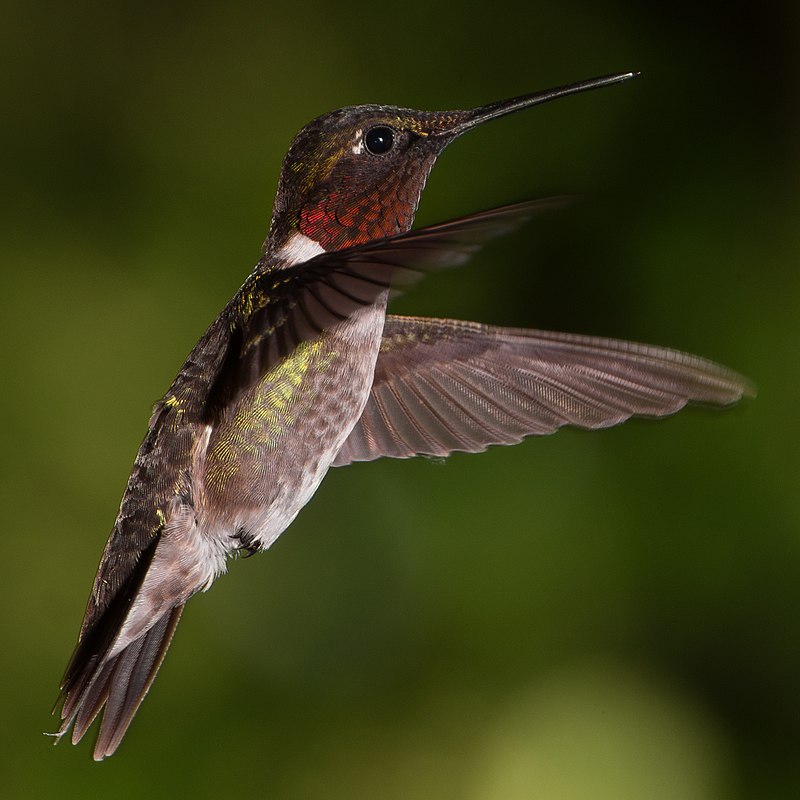
The ruby-throated hummingbird (Archilochus colubris) is a species of hummingbird that has an impressive migration pattern, spending the winter in Central America, Mexico and Florida before flying to Canada and other parts of Eastern North America for breeding season.
It’s by far the most common type seen east of the Mississippi River in North America.
Formally described by Swedish naturalist Carl Linnaeus in 1758, this tiny bird has bright metallic green upperparts with white underparts, a small black bill and a red throat patch which gives it its name; they measure around 3 inches long on average.
They feed primarily on nectar from flowers but also eat insects such as flies or mosquitoes for extra protein during their migrations or when raising young chicks.Scientific classification:
| Kingdom | Animalia |
| Phylum | Chordata |
| Class | Aves |
| Order | Apodiformes |
| Family | Trochilidae |
| Genus | Archilochus |
| Species | A. colubris |
39. Eastern Kingbird
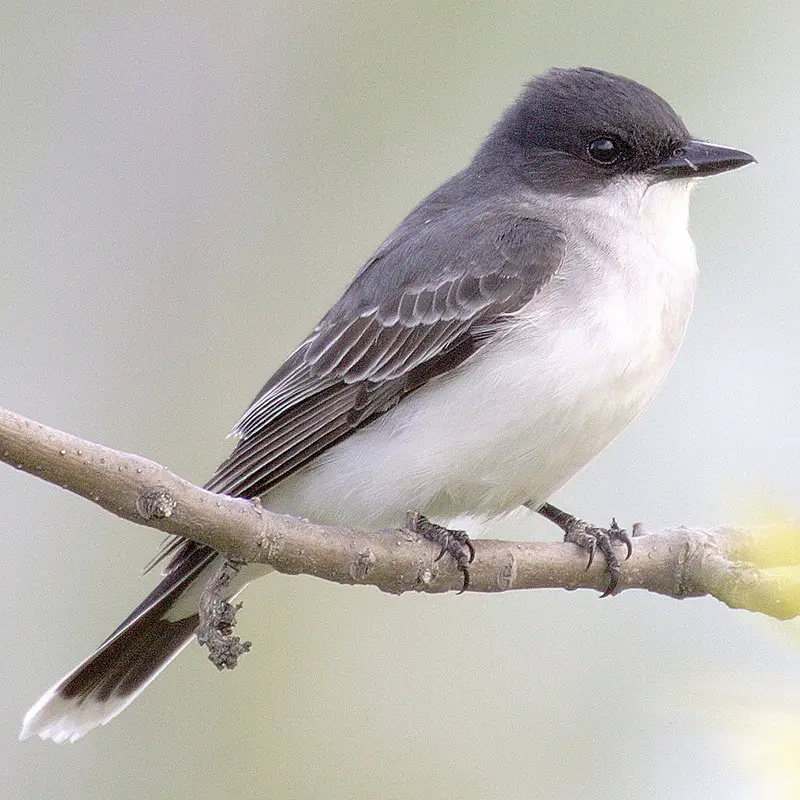
The Eastern kingbird is an impressive large grey bird, with a white underbelly and pointed wings. It can be seen perched atop trees or bushes in open areas while foraging for insects.
This species of tyrant flycatcher breeds across much of North America during the spring and summer months before migrating southwards come wintertime.
During this time, they have been known to travel as far south as Central and South America.
These birds are particularly territorial when nesting; having been observed chasing off even larger animals such as hawks away from their nests. A truly remarkable sight to behold.Scientific classification:
| Kingdom | Animalia |
| Phylum | Chordata |
| Class | Aves |
| Order | Passeriformes |
| Family | Tyrannidae |
| Genus | Tyrannus |
| Species | T. tyrannus |
40. Northern Bobwhite
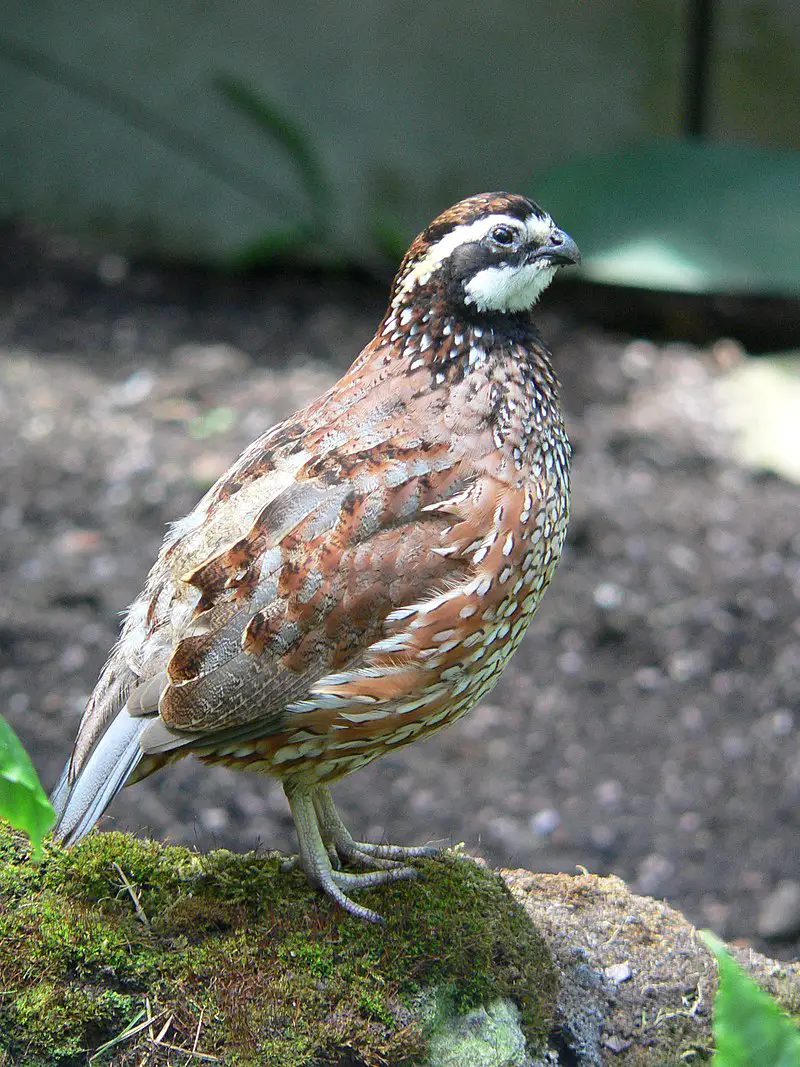
The Northern bobwhite is a ground-dwelling bird native to parts of the Americas, with introduced populations elsewhere in the world.
It belongs to the New World quail family and has a distinctive call that can be heard during mating season or when their territory is threatened.
They have mottled brown plumage which helps them blend into their natural habitats such as grasslands, wooded areas and open fields.
The male birds are slightly larger than females and they feed on small insects, seeds and plants.
These birds form monogamous breeding pairs that stay together throughout most of the year raising several broods each year until migrating south for winter months.
Though declining due to habitat loss, these resilient little birds can still be found living in many places across North America.Scientific classification:
| Kingdom | Animalia |
| Phylum | Chordata |
| Class | Aves |
| Order | Galliformes |
| Family | Odontophoridae |
| Genus | Colinus |
| Species | C. virginianus |
41. Eurasian Collared Dove
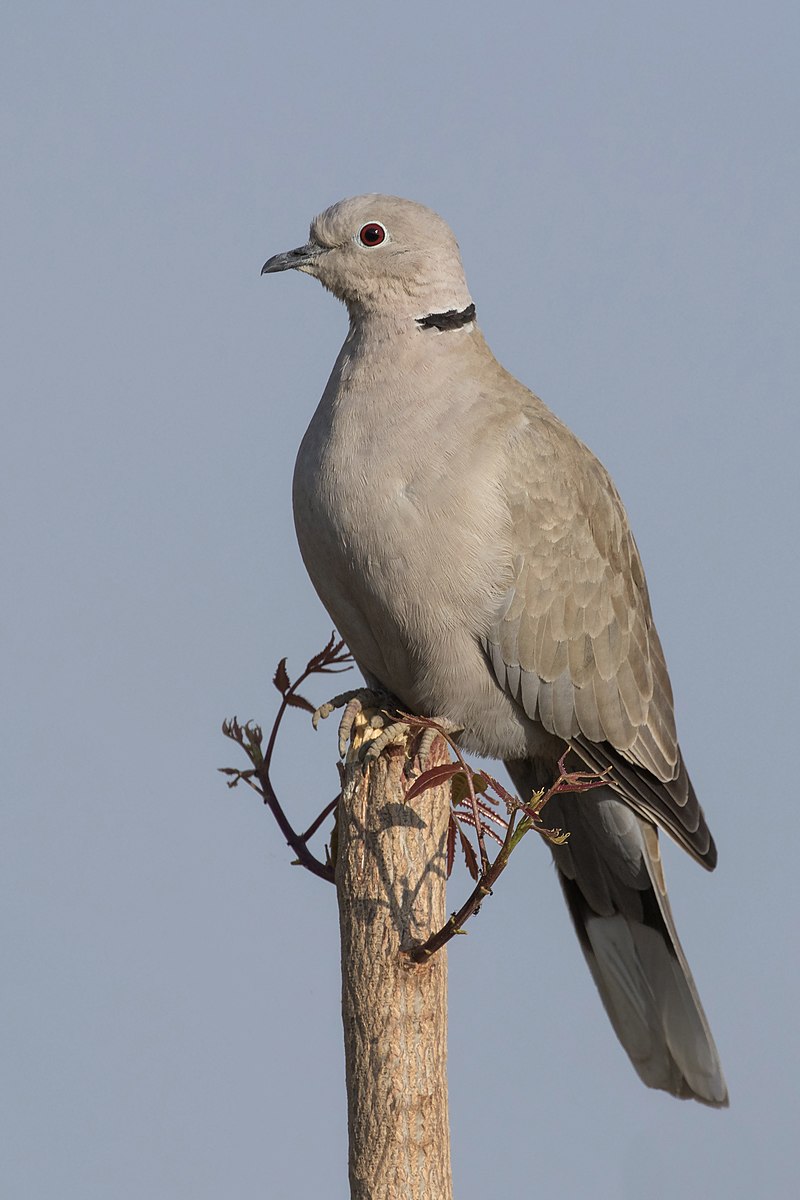
The Eurasian collared dove is a species of bird native to Europe and Asia, with its range expanding through introduction in Japan, North America, and islands in the Caribbean.
It has become so widespread that it is listed as Least Concern on the IUCN Red List. The scientific name for this bird was proposed by Hungarian naturalist Imre Frivaldsz – Columba decaocto.
This beautiful creature typically measures between 33-37 cm from tip to tail feathers, displaying an overall greyish brown plumage; they also have distinctive black half collar around their neck which gives them their common name.
These birds are mainly found inhabiting open woodlands or agricultural lands near human settlements where there’s plenty of food available such as grain fields or gardens where fruits can be eaten off trees.
With a vast global population trend increasing steadily each year these birds make great additions to many backyards throughout the world.Scientific classification:
| Kingdom | Animalia |
| Phylum | Chordata |
| Class | Aves |
| Order | Columbiformes |
| Family | Columbidae |
| Genus | Streptopelia |
| Species | S. decaocto |
42. Belted Kingfisher
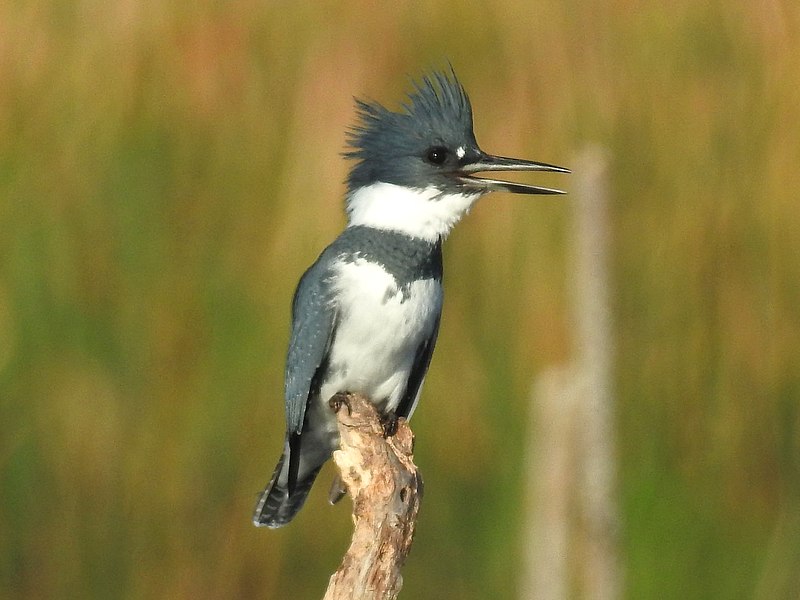
The belted kingfisher is a large, eye-catching bird native to North America. It belongs to the family Alcedinidae and has been divided into three subfamilies by recent research.
The species was first described in 1758 by Carl Linnaeus in his Systema Naturae.
This water Kingfisher stands out for its size as well as its striking plumage; males are bright blue on top with white below and females have rusty brown backs and wings with a thick black breast band across their chest.
They also possess an impressive call which can be heard from quite far away.
Belted kingfishers feed mainly on small fish but will sometimes also eat crustaceans, insects or even amphibians if they come across them while hunting around rivers or streams.
All in all, this is truly one remarkable bird that deserves our admiration.Scientific classification:
| Kingdom | Animalia |
| Phylum | Chordata |
| Class | Aves |
| Order | Coraciiformes |
| Family | Alcedinidae |
| Subfamily | Cerylinae |
| Genus | Megaceryle |
| Species | M. alcyon |
43. Snowy Owl
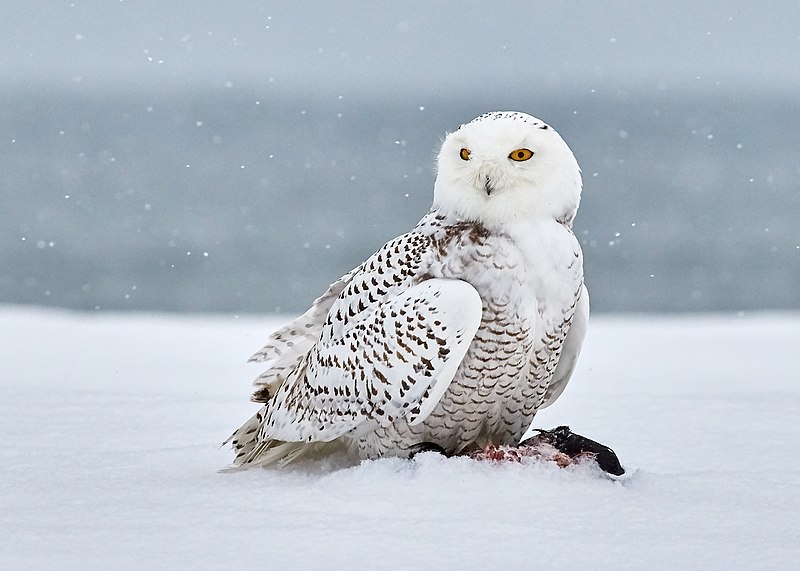
The Snowy Owl is an impressive bird of prey native to both the North American and Palearctic Arctic regions.
It has a unique white plumage that helps it blend in with its snowy tundra habitat, as well as several adaptations that make it suitable for life in cold climates.
These include thick feathers which insulate their bodies from frigid temperatures, large eyes adapted for hunting during long winter nights, and talons designed for gripping slippery surfaces such as ice or snow.
This majestic owl will soar high above its territory searching for food before gliding back down again to perch atop rocks or trees.
The Snowy Owl truly stands out amongst other birds of prey – an iconic symbol of the beauty and mystery of the north.Scientific classification:
| Kingdom | Animalia |
| Phylum | Chordata |
| Class | Aves |
| Order | Strigiformes |
| Family | Strigidae |
| Genus | Bubo |
| Species | B. scandiacus |
44. Harris’s Sparrow
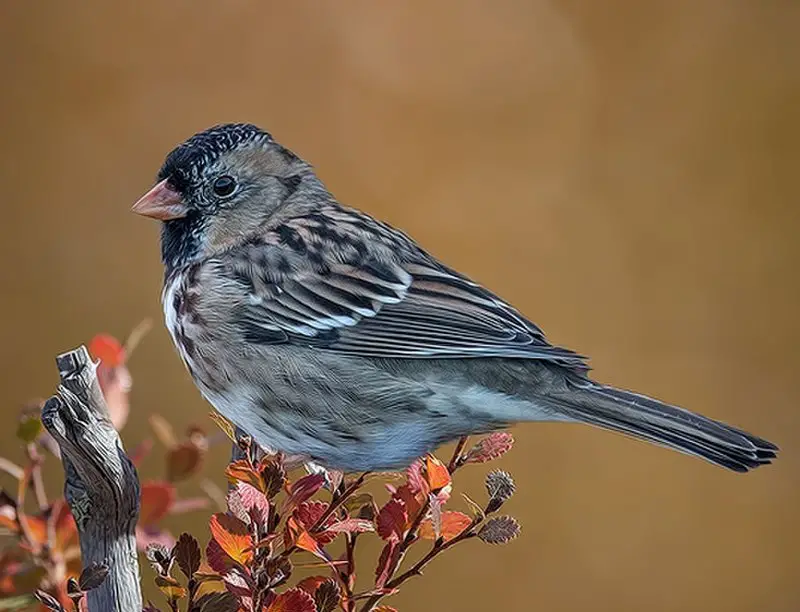
Harris’s sparrow is a large, distinctive bird that is endemic to Canada. It breeds in the north part of central Canada, mainly in Northwest Territories and Nunavut with its range extending into Manitoba and Saskatchewan.
During winter it migrates southward to states such as South Dakota, Texas or Nebraska where they can be found foraging on grasslands or prairies.
Its plumage includes white underparts with brown streaking on the sides accompanied by a grey-brown crown and black bill which makes it easy to identify.
Although not endangered yet due efforts should still be taken for conservation since their habitat loss has been affecting them adversely over time.Scientific classification:
| Kingdom | Animalia |
| Phylum | Chordata |
| Class | Aves |
| Order | Passeriformes |
| Family | Passerellidae |
| Genus | Zonotrichia |
| Species | Z. querula |
45. Yellow-Throated Vireo
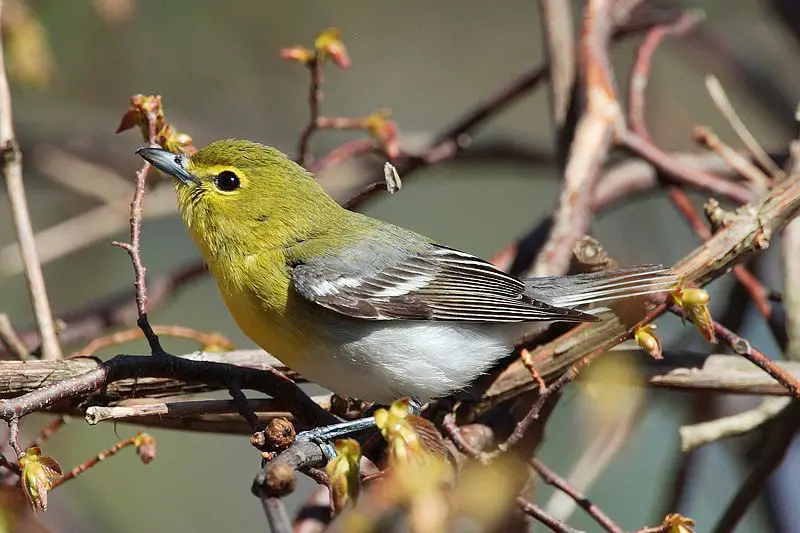
The Yellow-throated Vireo is a small songbird found in North America. It has an olive head and upperparts with a yellow throat and white belly, along with dark wings and tail feathers.
The vireo’s scientific name comes from the Latin words “flavus” meaning yellow, and “frons” meaning forehead – alluding to its distinctive colouring.
These birds feed mainly on insects which they catch by hovering over vegetation or flying out to seize them midair.
During breeding season males are known for their loud singing as they defend their territories against rival suitors.
Nonbreeding individuals may congregate in large flocks while migrating southward during autumn months, making quite a spectacle of themselves.Scientific classification:
| Kingdom | Animalia |
| Phylum | Chordata |
| Class | Aves |
| Order | Passeriformes |
| Family | Vireonidae |
| Genus | Vireo |
| Species | V. flavifrons |
Also Featured In: British Virgin Islands Birds You Need to See, Yellow Connecticut Birds
46. Black-And-White Warbler
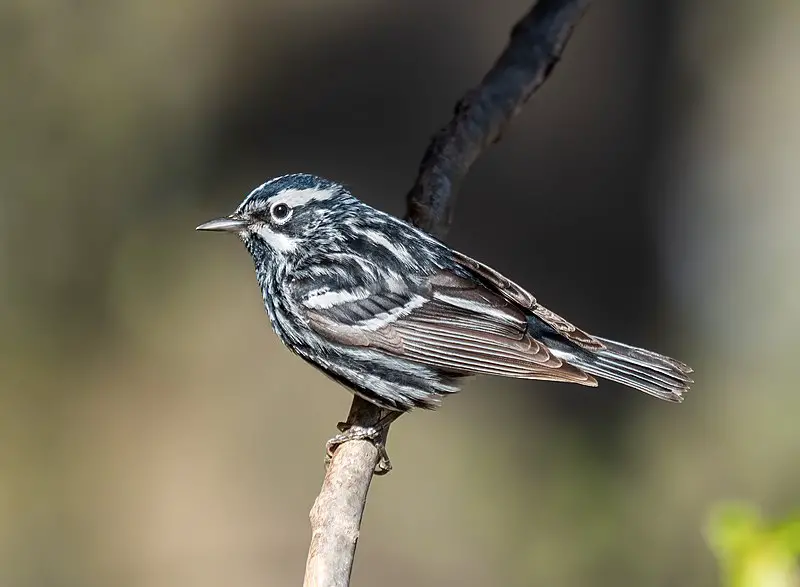
The Black-and-white Warbler is a unique species of bird native to North America. It has striking black and white plumage and breeds in the northern part of the continent, wintering in Central America, Florida, West Indies and Peru.
This warbler is rarely seen as far west as Europe but it’s still being studied for its behavior and ecology.
Its diet consists mainly of insects which it catches by clinging on trees like a woodpecker before quickly darting away again when prey appears.
The population size remains stable although they are vulnerable to habitat loss due to deforestation or other human activities so their conservation status should be monitored closely over time.Scientific classification:
| Kingdom | Animalia |
| Phylum | Chordata |
| Class | Aves |
| Order | Passeriformes |
| Family | Parulidae |
| Genus | Mniotilta Vieillot, 1816 |
| Species | M. varia |
47. Lewis’s Woodpecker
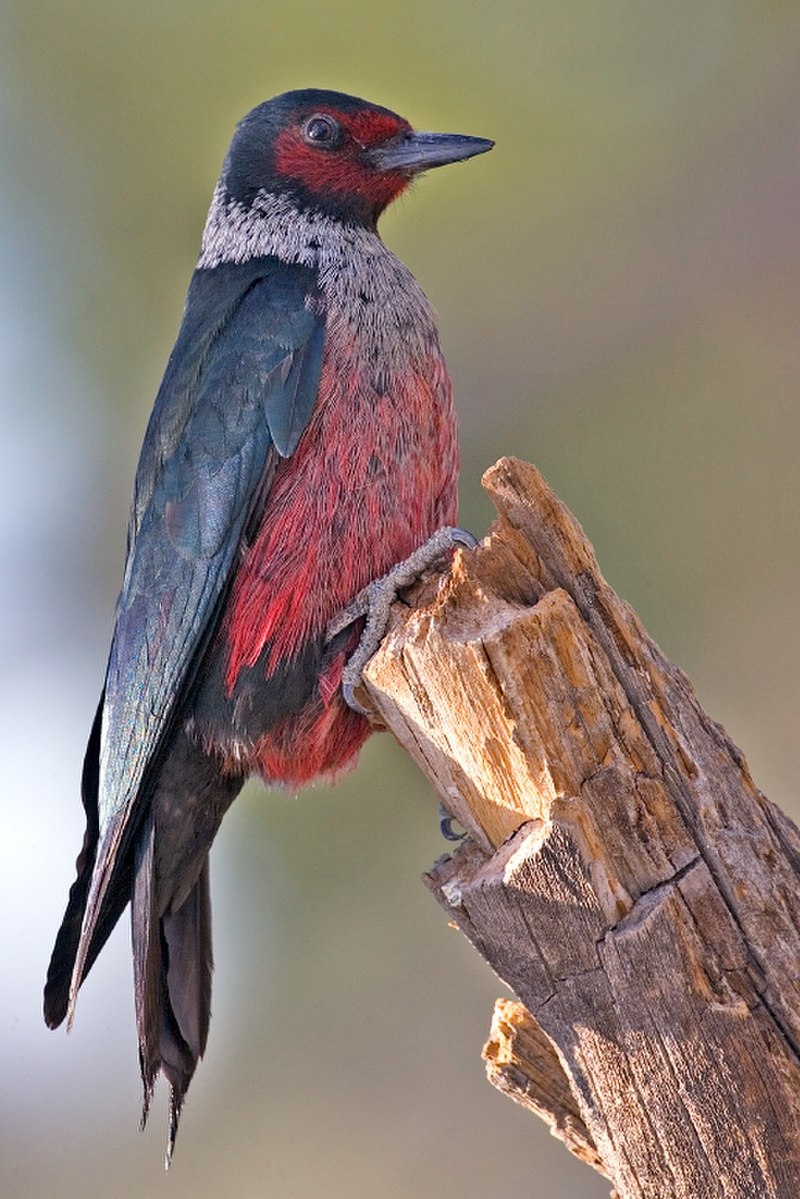
Lewis’s woodpecker is a large species of North American bird, discovered and named after Meriwether Lewis by the ornithologist Alexander Wilson.
Its body measures 18-23 cm in length, with a wingspan ranging from 25 to 30 cm.
It has dark plumage on its back and head that transitions into lighter brown feathers on its chest, belly and tail.
The male bird has bright red patches along the sides of his neck as well as at the base of his bill while females have pinkish or yellow tones instead.
This species primarily feeds on insects such ants which it finds underneath bark or near dead trees where they live their solitary lives except during mating season when pairs form temporary bonds for breeding purposes before going off alone again afterwards.Scientific classification:
| Kingdom | Animalia |
| Phylum | Chordata |
| Class | Aves |
| Order | Piciformes |
| Family | Picidae |
| Genus | Melanerpes |
| Species | M. lewis |
48. Yellow-Bellied Flycatcher
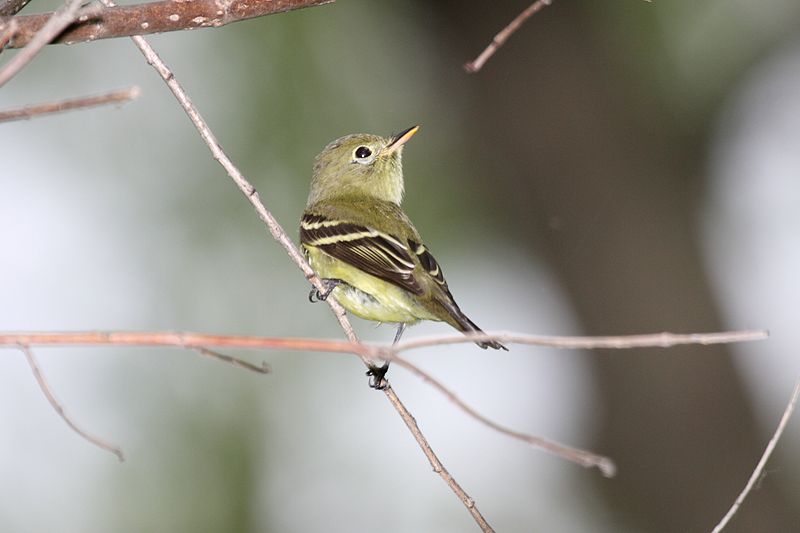
The Yellow-bellied Flycatcher is a small bird of the tyrant flycatcher family. It has greenish upperparts and yellowish underparts, with a dusky wash on its chest.
Its distinctive feature is the white or yellow eye ring that lacks any teardrop projection – setting it apart from other similar species in its family.
This insectivorous bird can be found in open habitats such as forest edges and woodland clearings across much of North America during summer months, when they migrate south to warmer areas for wintertime nesting.
They feed mainly on insects caught by sallying out after them from an exposed perch, but also take fruit occasionally at times of year when there are fewer flying insect prey available to eat.Scientific classification:
| Kingdom | Animalia |
| Phylum | Chordata |
| Class | Aves |
| Order | Passeriformes |
| Family | Tyrannidae |
| Genus | Empidonax |
| Species | E. flaviventris |
49. Canada Warbler
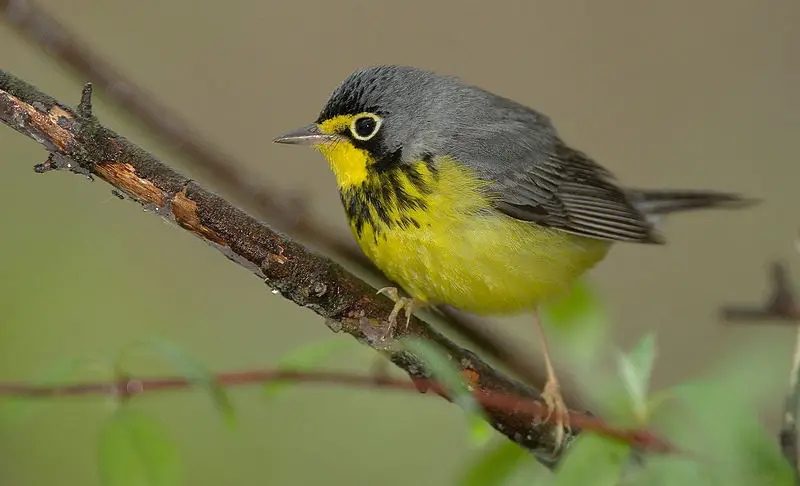
The Canada warbler is a small songbird of the Parulidae family, native to North America. It has olive-green upper parts with yellow underparts and white wing bars, making it easily identifiable.
During summer months they are found in Canada and northeastern United States while during winter their range extends to northern South America.
Mathurin Jacques Brisson was the first to describe this species in 1760 after he collected a specimen from Canada; which resulted in its French name Le gobe-mouche du Canada (Canada’s flycatcher).
Its diet consists mainly of insects such as beetles and mosquitoes, but also includes berries occassionally.
With an estimated population of 5 million individuals they remain common across much of their range although numbers have been declining due to habitat loss caused by human development activities like logging or agricultural expansion.Scientific classification:
| Kingdom | Animalia |
| Phylum | Chordata |
| Class | Aves |
| Order | Passeriformes |
| Family | Parulidae |
| Genus | Cardellina |
| Species | C. canadensis |